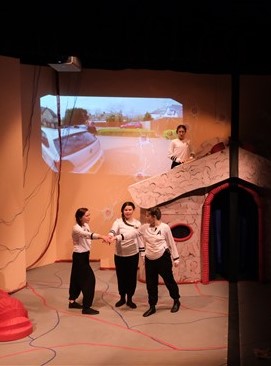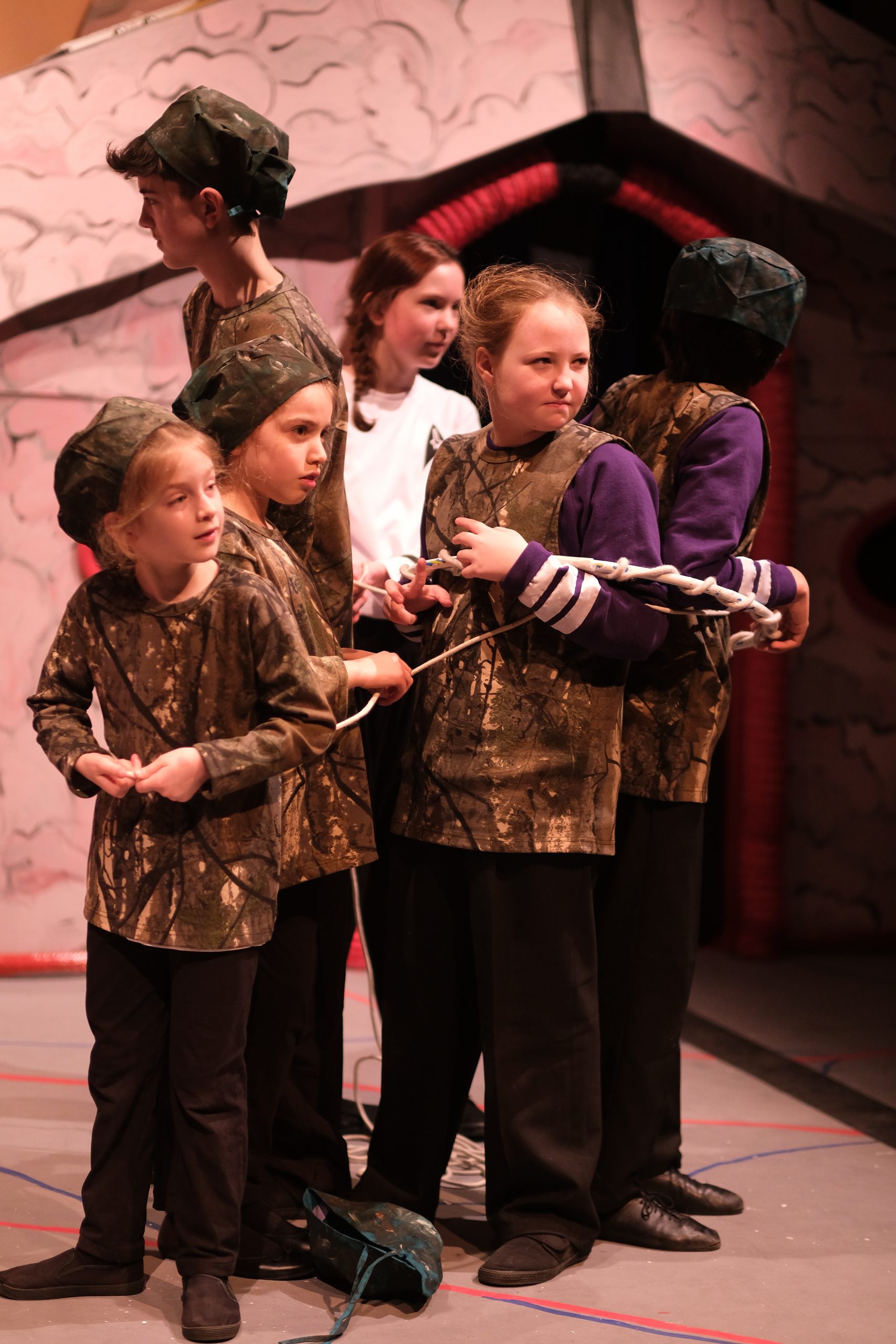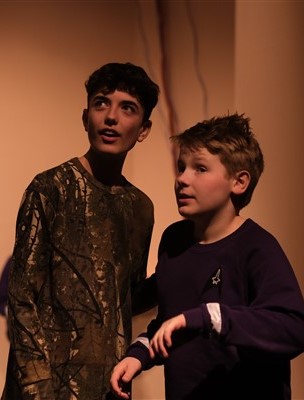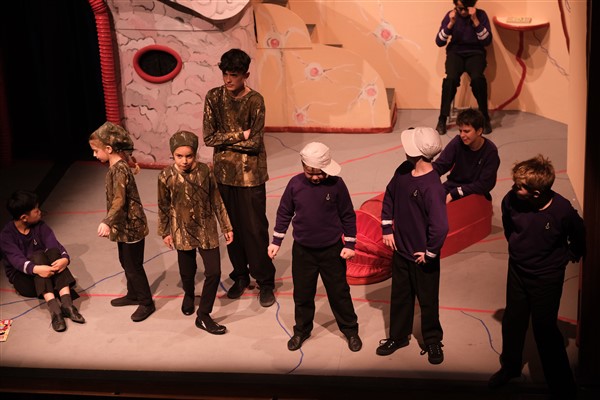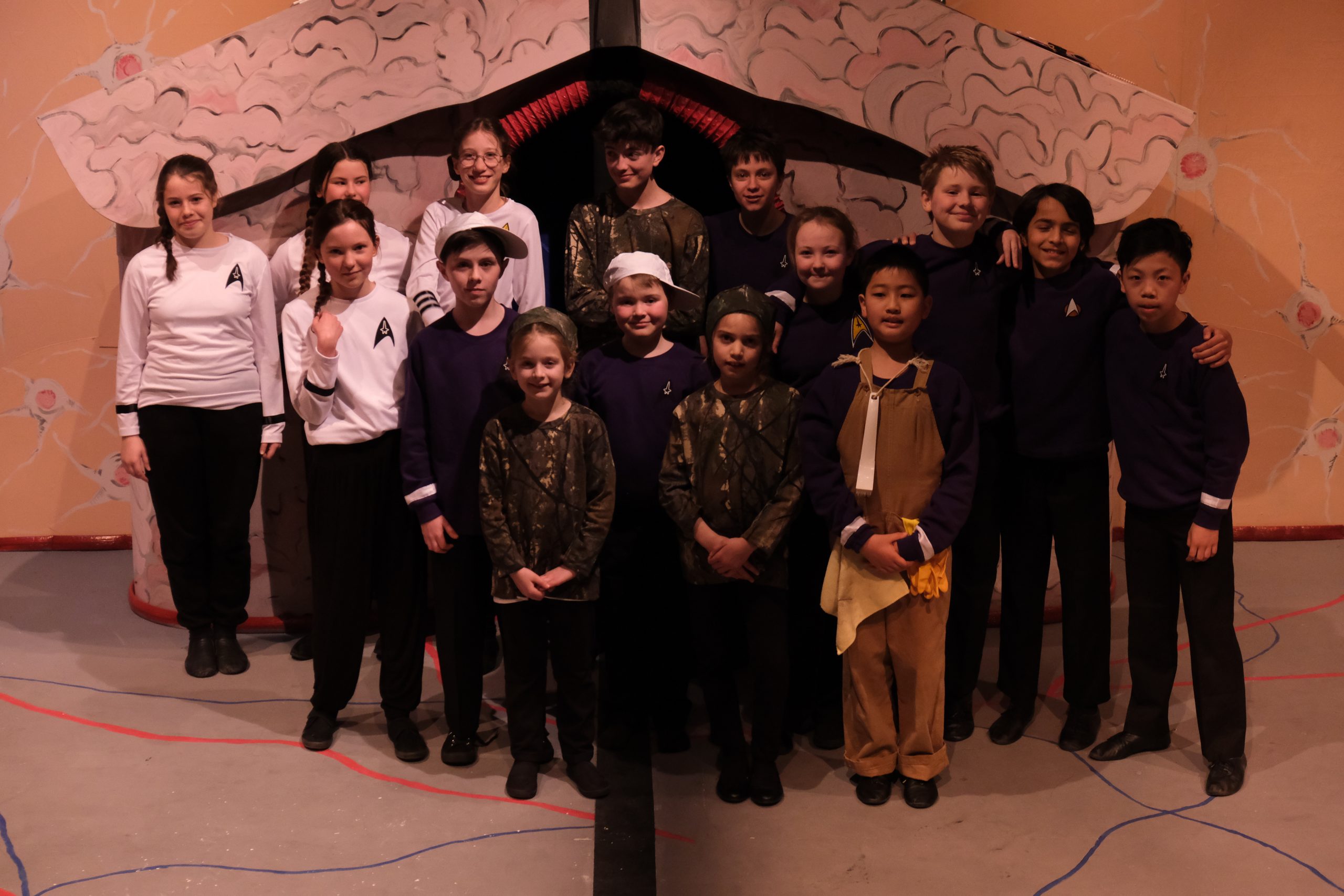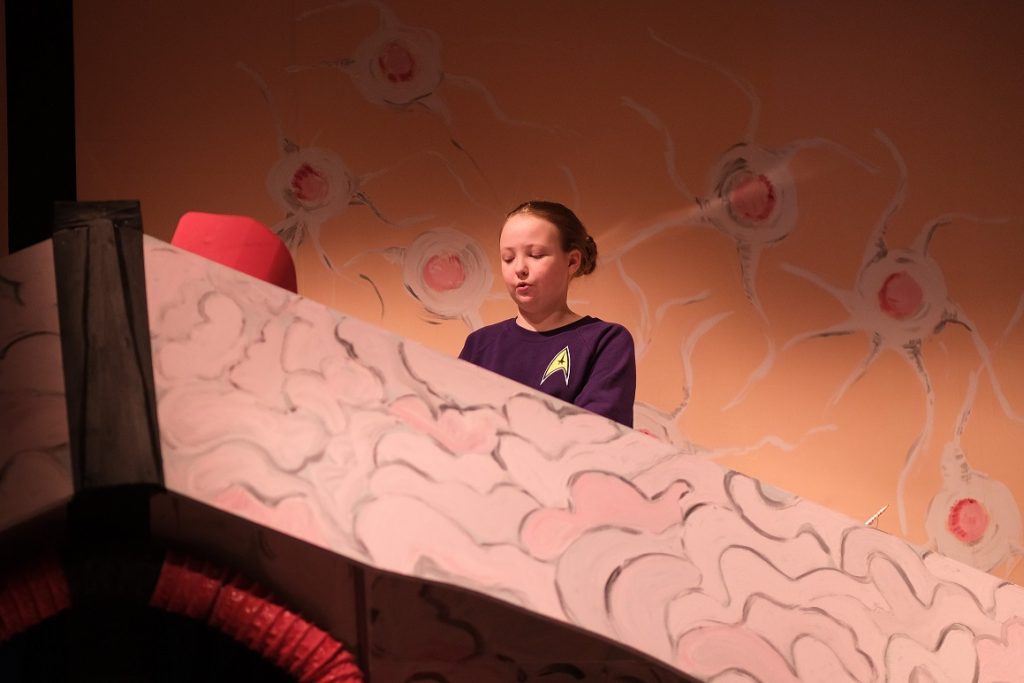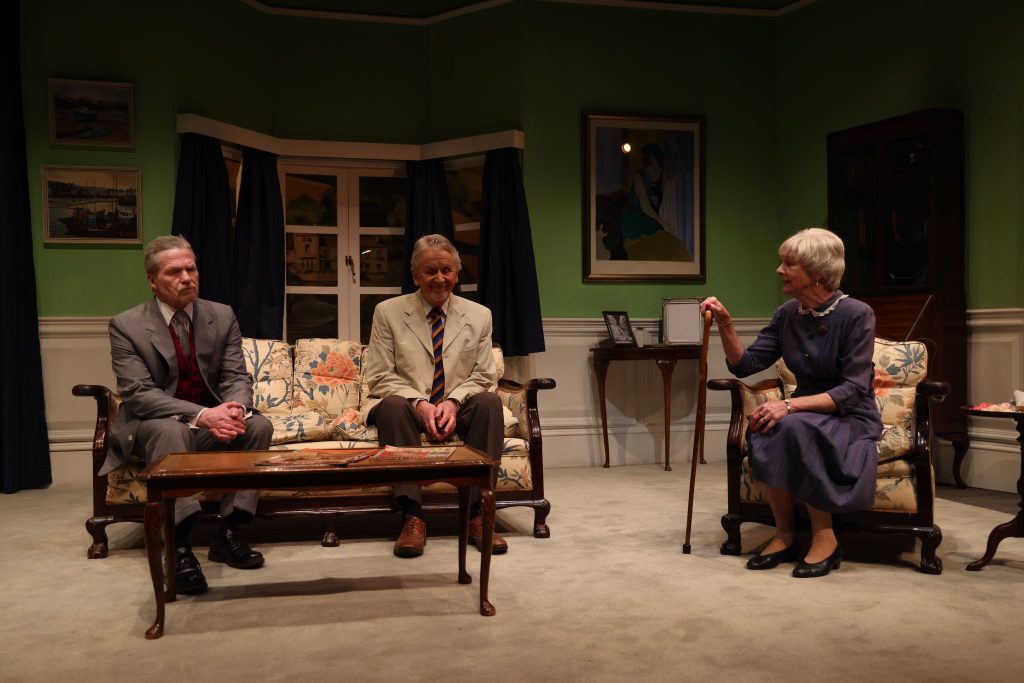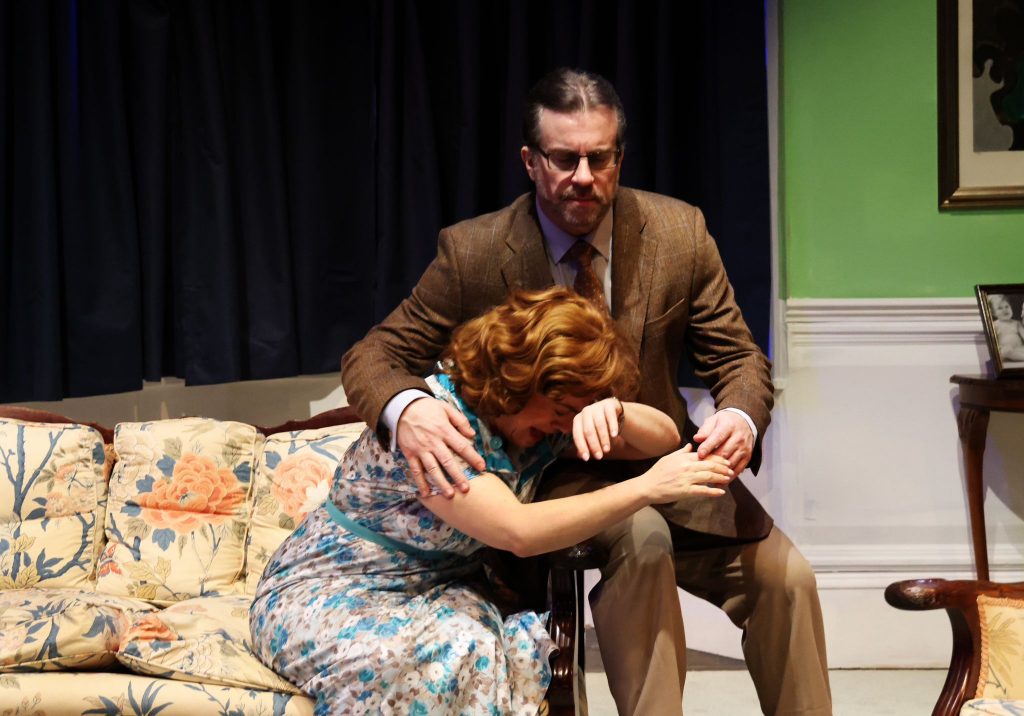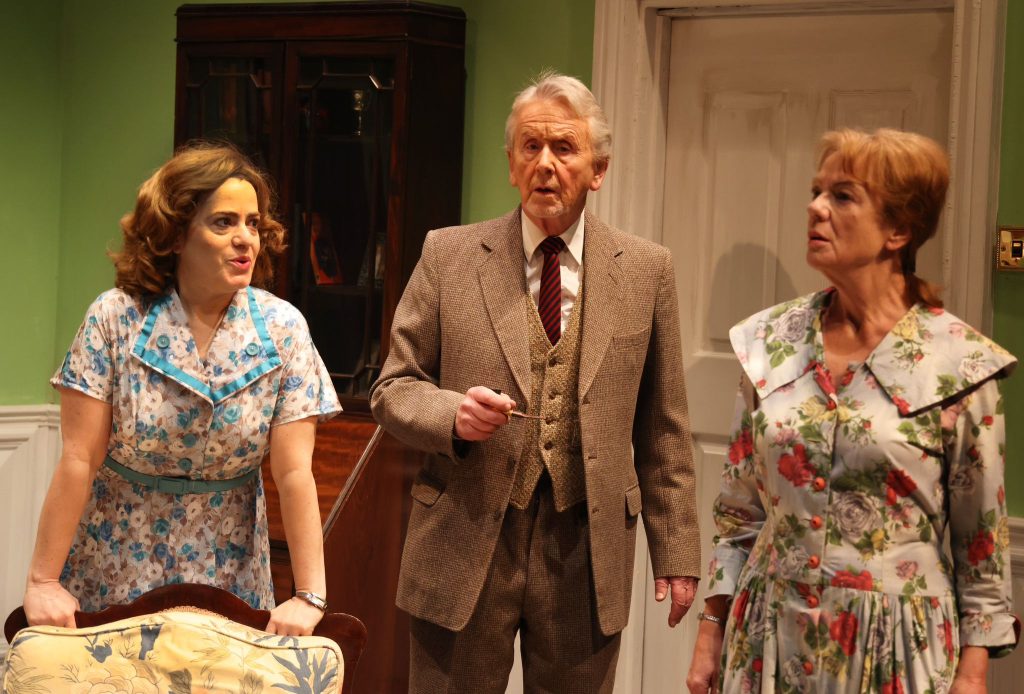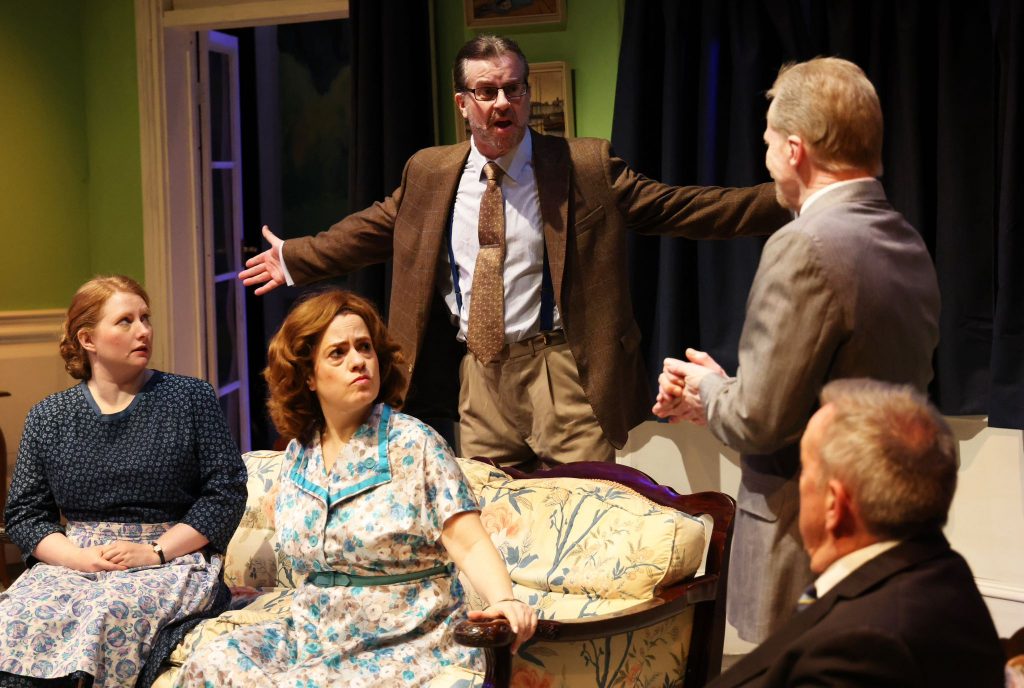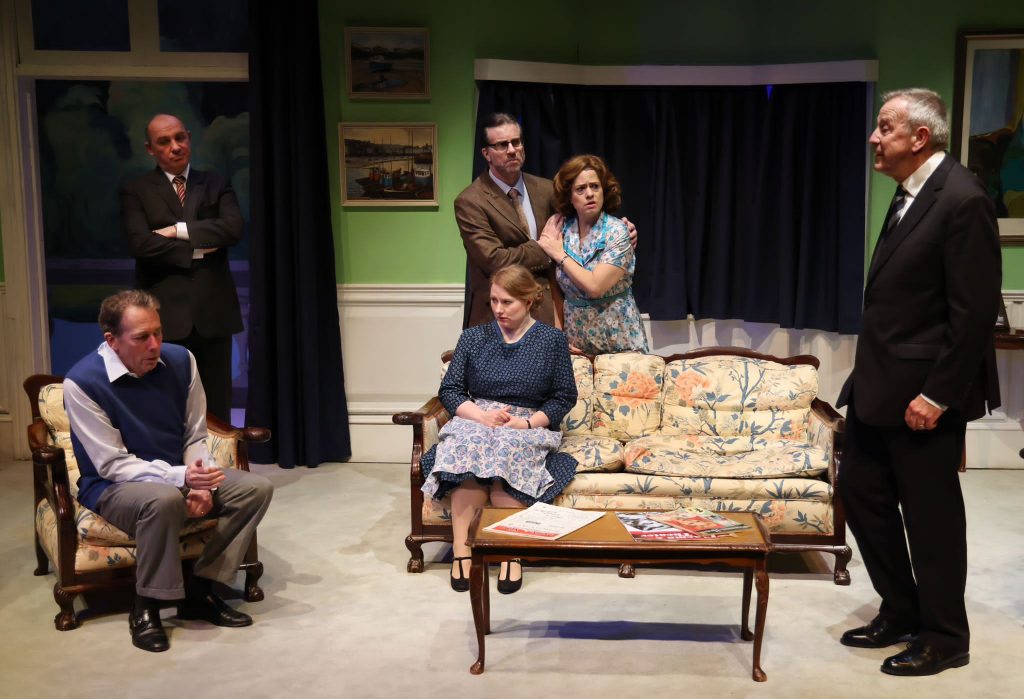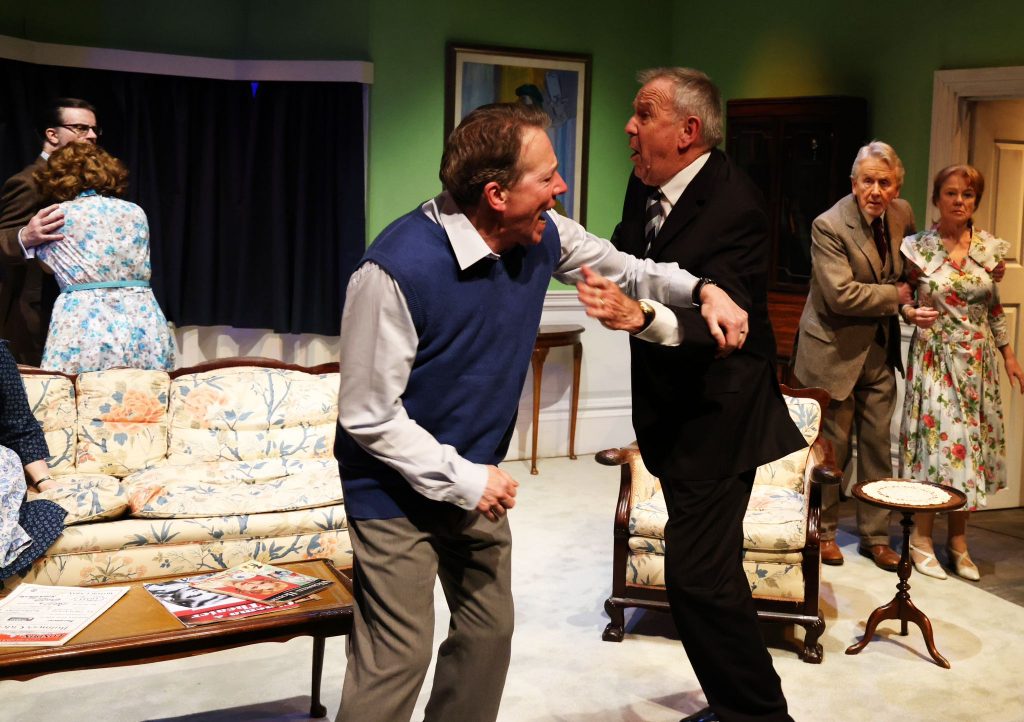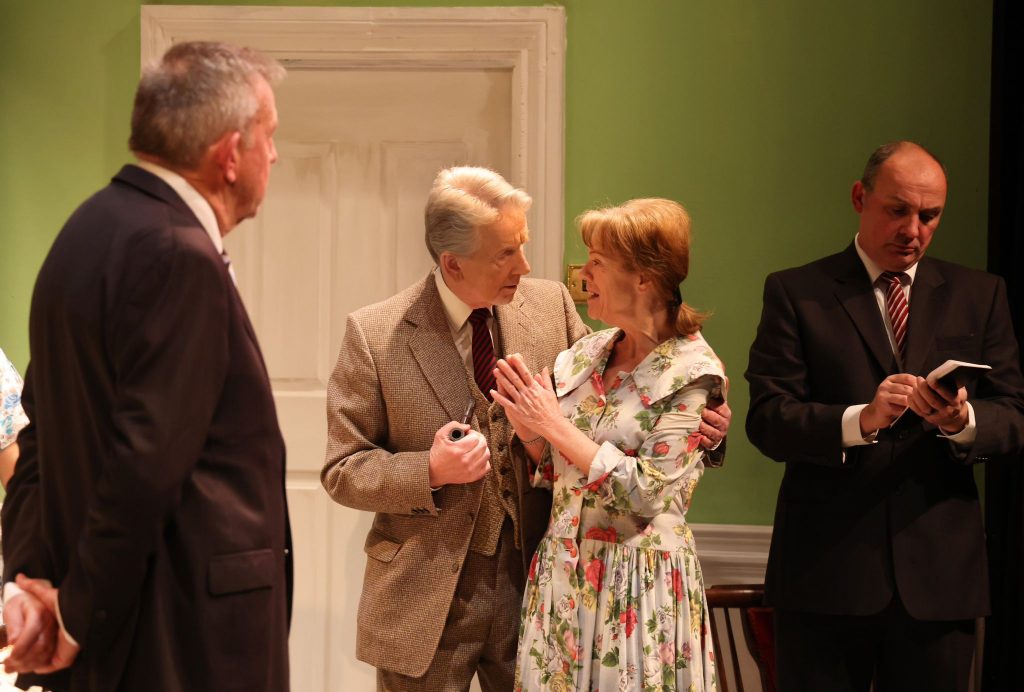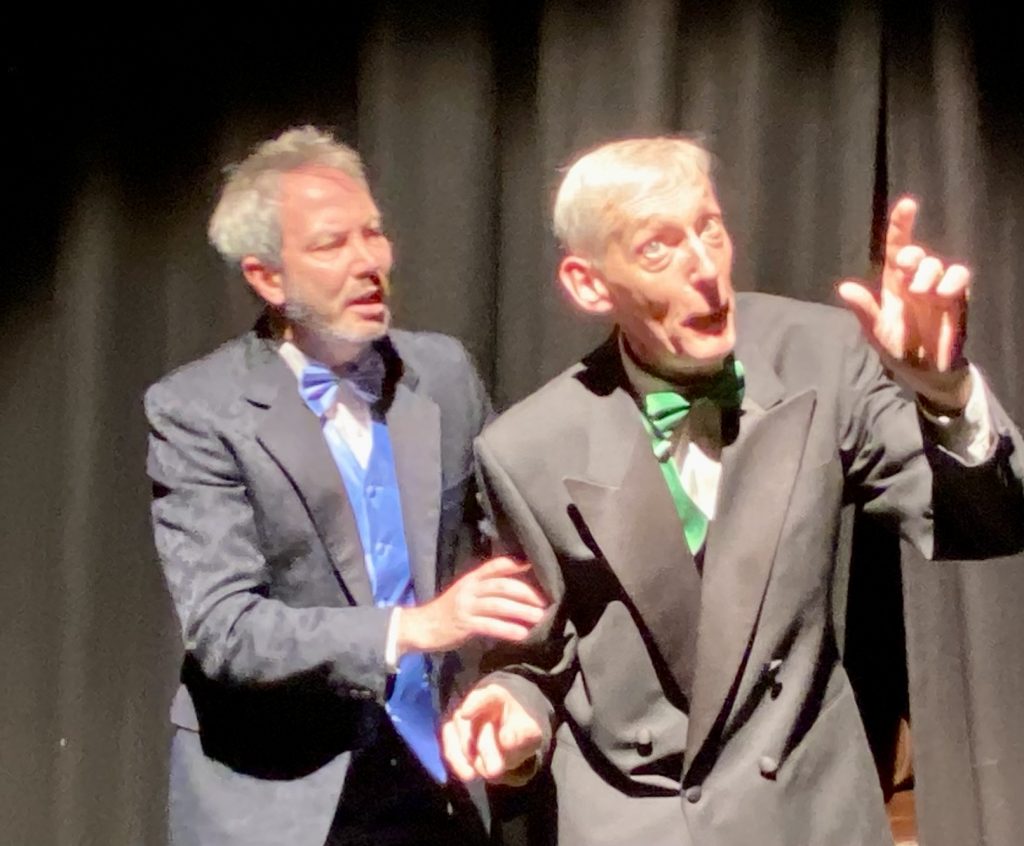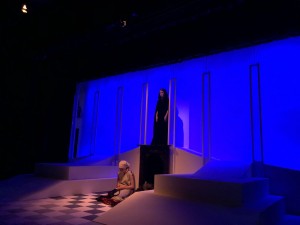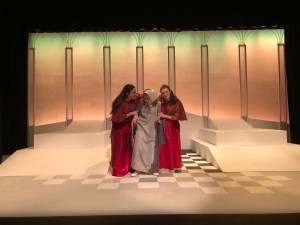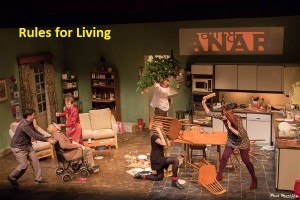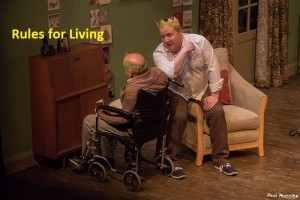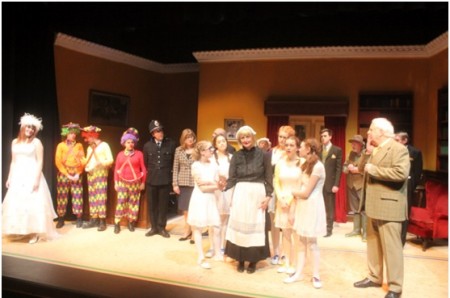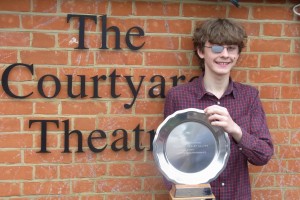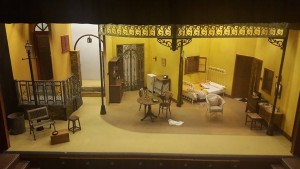The Chipstead Players’ AGM was held on THURSDAY JUNE 13th 2024
Minutes of recent AGM here soon
CLICK HERE for our list of forthcoming productions in 2024-25.
Please click on this link to see your invitation to join our
PLAY READINGS
PRESSURE
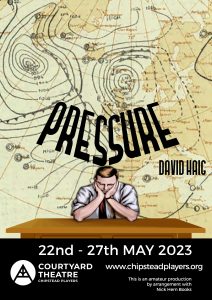
BODY TALK

TOWARDS ZERO

Towards Zero by Gerald Verner from Agatha Christie
Courtyard Theatre, Chipstead, February 2023 – reviewed by Lauren Milsom-Harris.
Gerald Verner’s version of this lesser-known Agatha Christie whodunnit is perfect fare for the Courtyard audience, as proved by selling out so quickly. The title “Towards Zero” refers to the somewhat unusual premise for this detective story in that the murder comes nearer the end of the story rather than at the beginning. All the action leads inexorably towards the Zero Hour when the dénouement takes place.
The setting for the drama is the drawing room of elderly Lady Tressilian’s seaside home set near the Cornwall cliffs of Gull’s Point. The set itself is a standard box set, elegantly staged and decorated by Keith Miller and the Chipstead Construction Crew, and perfectly furnished by Mags Alexander and Paul Dickson. The focus for attention that brings the coastal beauty of the setting to life, however, is the stunning backdrop drawn and painted by Jess Doherty with help from Sue Millman and Keith. The hotel on the opposite side of the bay is clearly seen through the window, giving the set an extra dimension and a real “Riviera” feel.
As is often the case with a Christie murder mystery, the action centres on a house party, with Lady Tresillian, played by Jan Robinson with perfect pitch, as the curmudgeonly hostess, using her great age and status to cast critical judgement on each of her house guests in turn. Her long-suffering assistant Mary Aldin is given efficiency and patience by Bev Davies, whose gentle yet strong performance hints at genuine empathy and concern for her employer. As the characters all arrive, it becomes clear that some members of the gathered company are on less than convivial terms. The tension centres on successful, sporty high achiever Nevile Strange and his two wives, current, Kay, and former, Audrey, both of whom are guests at the house, resulting in a potentially uncomfortable situation.
Ian Brown gives Nevile a keen energy and air of confidence befitting a successful tennis player and climber, and his obvious affection for his former wife Audrey is clearly portrayed from his first entrance. Ian’s development of the character is excellent as his troubled relationship with current wife Kay and tensions with other house members, particularly Thomas Royde, become clear.
Royde makes the earliest entrance on to the stage, as a newly-arrived house guest with a history of unrequited love for the now-single Audrey, and a wish to ask her to marry him. Audrey, played with a composed dignity by Elayne Teague, is often emotionally distant during her interactions with other house guests, making her obvious joy and relief at Royde’s arrival a marked contrast. Through the play she evidently sees Royde as a trustworthy confidant and friend. In the capable hands of Chester Stern, Royde’s disposition as a likeable yet awkward under-achiever, subtly develops through the course of the drama, as he becomes Audrey’s rock and the voice of reason in many of the tense scenes.
Nevile’s current wife Kay Strange, (Susan Marinakis) is infused with a narcissistic confidence that belies her emotional frailty. The presence of Audrey in the house, and Nevile’s keen interest in his former wife to the point of obsession, bring out the worst in Kay’s character. Her child-like need for attention and blatant resentment of Audrey often make her behaviour jarringly fractious, and director Will Harris has cleverly used this to comedic effect in certain scenes, to provide the audience with opportunity to warm to Kay’s character, which we do as her own plight in this doomed relationship becomes more obvious.
Kay has a constant admirer on hand in the form of Ted Latimer, her devoted friend and erstwhile suitor, played with an easy charm by Noel Harris. Ted is residing at the Easterhead Bay hotel in order to be close to Kay and makes it his task to allay her obvious boredom during the stay with regular tennis games, bathing and coastal drives. The inevitable friction between Latimer and Neville Strange takes an interesting turn as the play develops, with Strange actively choosing Latimer’s company in an uneasy alliance that provides a vital alibi for Strange after the murder.
The house party is completed by elderly ex-lawyer and family friend Mathew Treves. Neil Black gives Treves the distinguished shrewdness that is essential to the part, as he becomes increasingly involved in the developments as the plot thickens, acting as a voice of reason and clarity not only for the other house guests, but for the audience.
When there is a murder in the house, all remaining occupants soon become suspects. The arrival of Superintendent Battle, played with commanding gravitas by Charlie Crowther-Smith, and Inspector Leach, a keen yet relaxed performance by Keith Miller, brings heightened tension. Ably supported by PC Benson, well characterised by James Willis in his first speaking role, the detectives’ gentle yet persuasive interrogations unveil layers of intriguing possibilities.
During the interval, it was a pleasure to hear the buzz of debate and conversation among members of the audience as they exchanged theories as to the perpetrator, so successfully had the play captured their imaginations.
The play reaches not one, but two, dramatic conclusions, the final scenes bringing out passion, anger and resentment in the characters as tempers flare and the perpetrator is revealed.
This was a good looking and well-staged production, expertly and sensitively lit by Jonathan Laverock and with evocative sound by Gemma Bottomley. The costumes were elegant and effortlessly fitting for the period thanks to Anne Franks, ably assisted by Nicki Thomas and Margaret Palmer.
Director Will Harris brought together all these excellent elements to create a tense, visually pleasing and often keenly humorous production that kept the audience gripped to the end.
Well done to all involved.
Lauren Milsom-Harris
5th March 2023
THE SNOW QUEEN
Directed by Sharon Laws and Rick Thompsett
CLICK HERE to read the review of this production, which has been highly praised by the audiences. The cast have had a wonderful time preparing it all for you, and many congratulations go to everyone who made it happen.
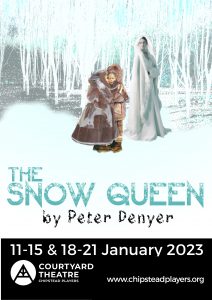
11th to 21st January 2023.
HANGMEN
Directed by Anne Gregory
CLICK HERE to read the review of this brilliant sellout production
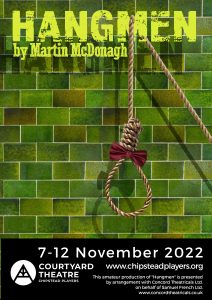
7th to 12th November 2022.
MOONFLEECE
Directed by Emily Foster (mentored by Jane Foster)
CLICK HERE to read the review of this excellent production
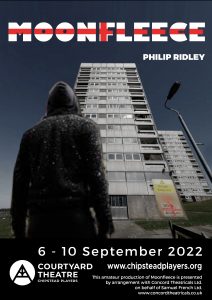
6th to 10th September 2022.
THE 39 STEPS
Directed by Lauren Milsom and Noel Harris
As the programme tells us, this production had five actors playing 139 characters and providing 100 minutes of abundant comedy and action. It was a sell-out run and a wonderful, light-hearted way to end our season. Covid has by no means gone away and it struck during the rehearsal schedule, causing headaches in more ways than one, but we were lucky to have an illness-free week.

Much of the delight of this production results from the inspired imaginations of the directors, Lauren Milsom and Noel Harris, who not only controlled the chaos very skilfully but who also devised some very smart ways of conveying the challenging demands of the action and locations. The London Palladium? An upmarket London 1930s’ flat? The Forth Bridge? The Scottish moors? The cockpit of an aeroplane? All these and more were cleverly represented for the audience and the change from scene to scene was slick and unobtrusive. As part of the charm, the fact that this was a spoof and a theatrical construct was sometimes shared with the audience, such as when the script referred to a car and the actors suddenly realised that they needed to build one.
The action begins when two thugs, played by Brian Aris and Nick Foster, with turned-down trilbies and upturned collars, ruthless members of a German spy ring, lurk under a lamp in the street outside Richard Hannay’s Portland Place flat. Ben Hilder, playing Hannay, is dapper and pencil-moustached, holding the whole play together with a fine sense of style.
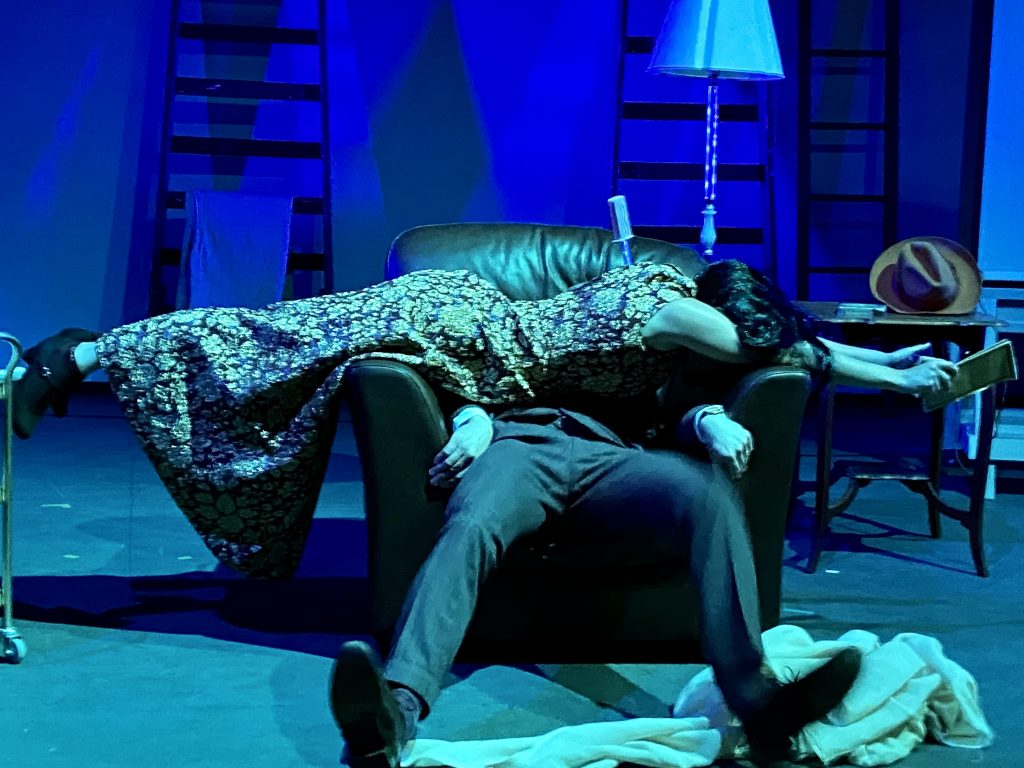
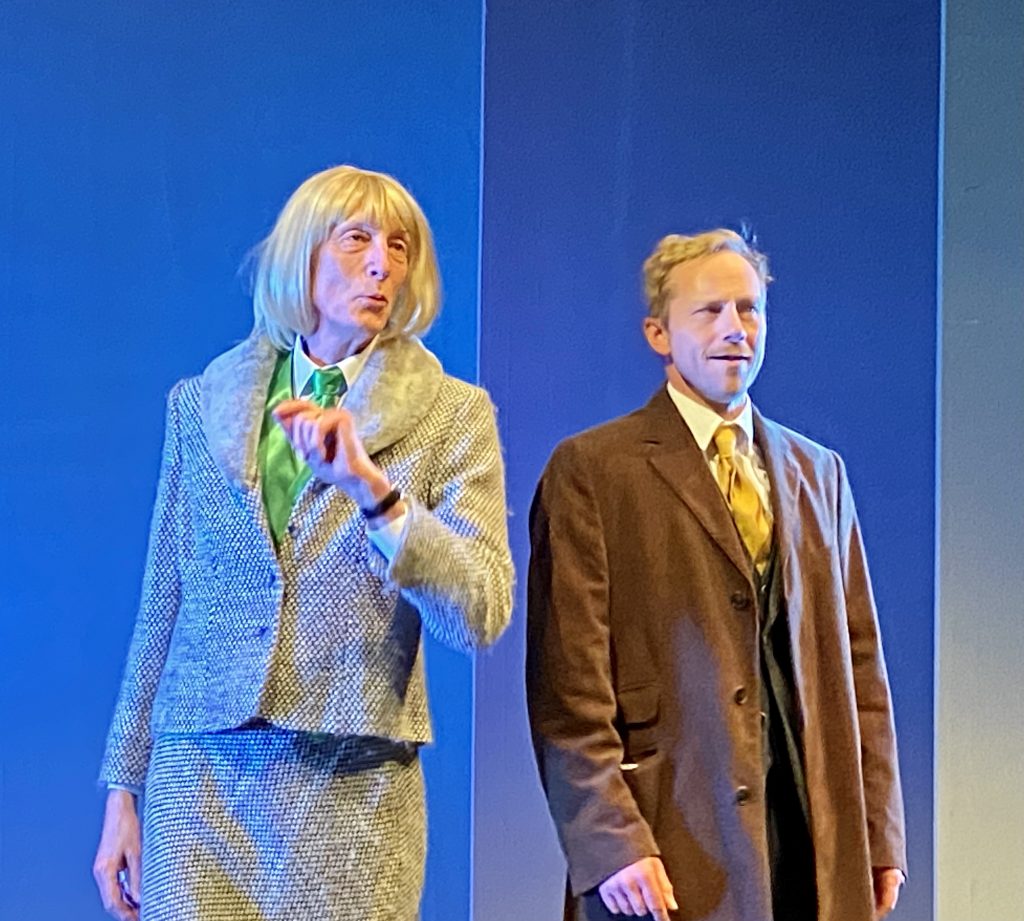
A glamorous femme fatale played by Fran Loosley with her husky mittel-European accent, ends up sprawled across an armchair in Hannay’s flat with a knife in her back. Later, she also plays the sex-starved crofter’s wife Margaret when the action moves to Scotland. Laura Worley plays Hannay’s love interest, attached to him physically by handcuffs for part of the play and inevitably falling for the urbane Hannay. Throughout the play, Brian Aris and Nick Foster provide a string of brilliant cameo gems, including cops, crooks, pipe-smoking lingerie salesmen, a sinister Nazi professor and an electioneering chairman with an impenetrable Scottish brogue, all achieved via a swift change of costume and persona. This is a very capable cast and all five provide energy and talent.
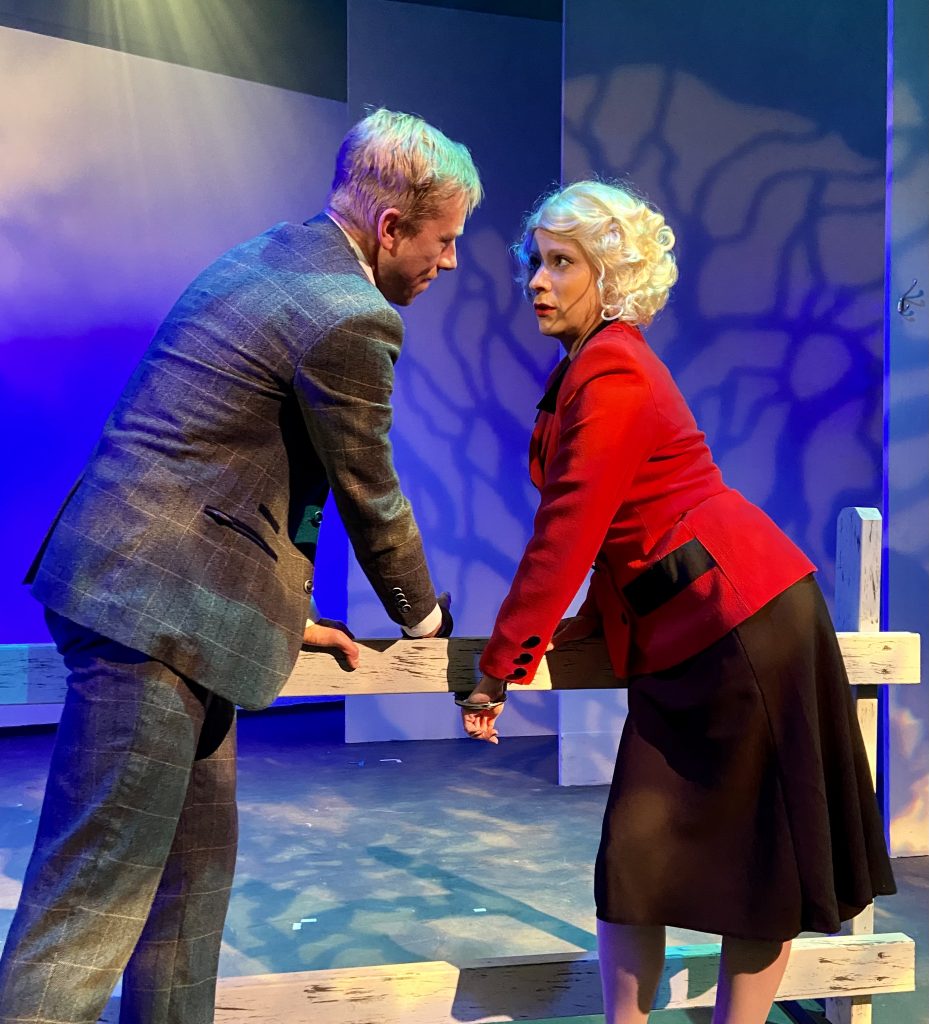
The members of the backstage crew were responsible for excellent period music, costumes, and minimal settings. Thanks must go to everyone involved including Mary Morgan, Linda Hornzee-Jones, John Fitzwater and Nick Gane. The lighting and sound cues must have looked like a telephone directory – remember those? – and so special appreciation must go to David Boyd, Alan Magrath and Mel Morgan. Wardrobe, quick changes and props were all brilliantly handled by Lorraine Bygraves, Sandy Kirk, Wendy and Nikki Ager, Mags Alexander and Eve Poole.
Julie Cumbo
THE KEELEY PLATE 2022
The Keeley Plate was awarded at The Players’ AGM, held on Wednesday June 15th.

The joint winners were Ella Yeloff and Charlie McCarthy.
CLICK HERE to read the Keeley Plate award report from the AGM held on June 15th 2022
THE WOMAN IN WHITE
Directed by Eve Manghani
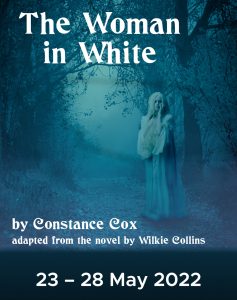
23rd to 28th May 2022.
Click here to read the review posted on Reigate and Banstead Writes by Kay Hymas






OUR DAY OUT
Directed by Debs Brooks, assisted by Beth Brooks and Bradley Adams
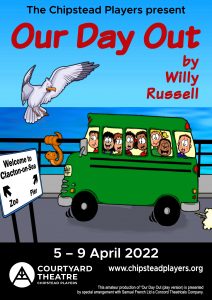




CLICK HERE to read the review




The Last of the Haussmans
Directed by Julie Cumbo
Extremely well done to everyone involved – this was a cracking show.
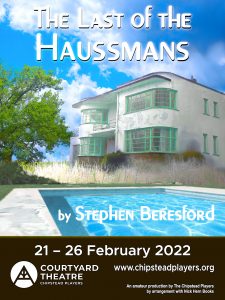





Goodnight, Mister Tom
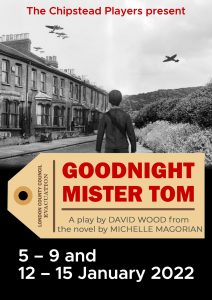
(CLICK BELOW TO VIEW)
https://reigateandbansteadwrites.com/2022/01/08/goodnight-mr-tom-presented-by-chipstead-players/
Here are some other images from this production:






On Golden Pond
by Ernest Thompson
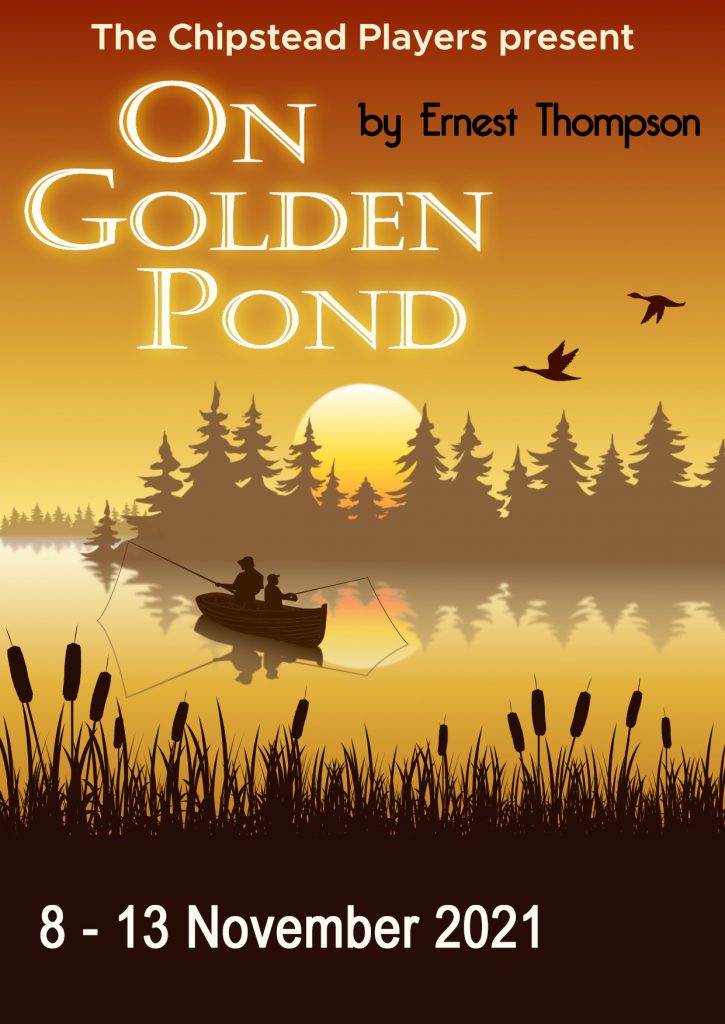






Reviewed by Kay Hymas, Reigate and Banstead Writes
Click here to read the review on their website
The Chipstead Players present Treasure Island.
‘Yo Ho Ho and a Bottle of Rum.’
The famous rousing pirate chant is more reminiscent of a celebratory songs from sporting crowds, as an audience, delighted to be back at the Courtyard Theatre, took their seats with the famous shanty ringing in their ears. We were eagerly anticipating the Chipstead Player’s Youth Theatre production of Treasure Island. It’s been a long wait to see live theatre and this talented group of youngsters, – all clearly loving treading the boards did not disappoint.
Directed by Debra Elsdon – her sixth time for the players with able assistance from 19-year-old Bradley Adams. This is a good-humoured adaptation which still retains enough of the terror and darkness at the heart of Robert Louis Stephenson’s classic story.
The adventure begins in the Admiral Benbow inn, where we meet the young Jim Hawkins; the heart and soul of the story as well as its narrator. His imagination and wonder-lust is fired by Cap’n Bones (Amar Hammond-Reid in his debut role for the players) bold tales of maps, curses and adventure.
Ronan O’Leary is perfectly cast as the innocent, wide-eyed Jim whose belief that the world is a fair and good place is about to be put to the test by his entanglement with pirates in the search for buried treasure. It may be a dark and thrilling tale but in essence, Treasure Island is a coming of age story.
The infamous anti-hero, Long John Silver is introduced to us through warnings from others.
“Look out for the one-legged man” says Cap’n Bones before he succumbs to the Black Spot. And by the time Samuel Norris as Silver, limps authoritatively onto stage ,capturing all his Machiavellian, manipulative charm, we, the audience are aware of Silver’s complexities and that he is a character best avoided.
After they both board the good ship Hispaniola to seek the hidden treasure. Hawkins as one of Squire Trelawney’s men; Silver masquerading as a cook. It isn’t difficult to see why Hawkins regards Silver as a father-figure. The on-stage chemistry between Norris and O’Leary is always believable. At times, I forgot that Norris is still a sixth-form student.
Silver acts as mentor and teacher to the adventure-craving Hawkins which must have made the subsequent betrayal; after Hawkins overhears Silver plotting, with his old crewmates, to kill all of the Squires men even more brutal. A pivotal moment as young Jim finds his courage and stands for what he believes is fair and just
The subsequent fight scenes between the pirates and the Squires men are brilliant. The young cast relishing the chance to brandish their swords with bloodcurdling yells and their footwork was worthy of a turn on Strictly.
The scene stealer is Charlie McCarthy’s tortured Benn Gunn, his comic turns exposing some harsher realities, money and greed corrupt. He is mesmerising and judging by the audience response, they agreed.
The Chipstead Crew, Production and Stage managers did a brilliant job with props, lighting and set design. The smaller stage captures the claustrophobia and cramped conditions on board an 18th century ship and the lighting, the brilliant blue sky and claps of thunder resounding from the back of the theatre swirling the audience directly into the action with plenty of gasps of appreciation from those seated around me.
You feel the sea-salt spray on your face and lips and the rush of adventure Jim must have felt. It brought to mind another description of a ship; C.S Lewis’s Voyage of the Dawn Treader where the protagonists slowly become part of a painting.
There are great turns from all of the word-perfect young cast. Remarkably, they only had a mere 10 days to learn their scripts, practice sword-fighting and put this show on the road. It was seamless. Congratulations must go to all of the cast, crew and backstage volunteers. This was an entertaining show that remained true to the original novel.
It’s a pirate’s life for me.
If you haven’t visited the ‘little theatre in the countryside’ check out one of the Chipstead Players’ upcoming productions.
Full details on the Players’ website.
The Chipstead Players performed Treasure Island 8-11th September 2021.



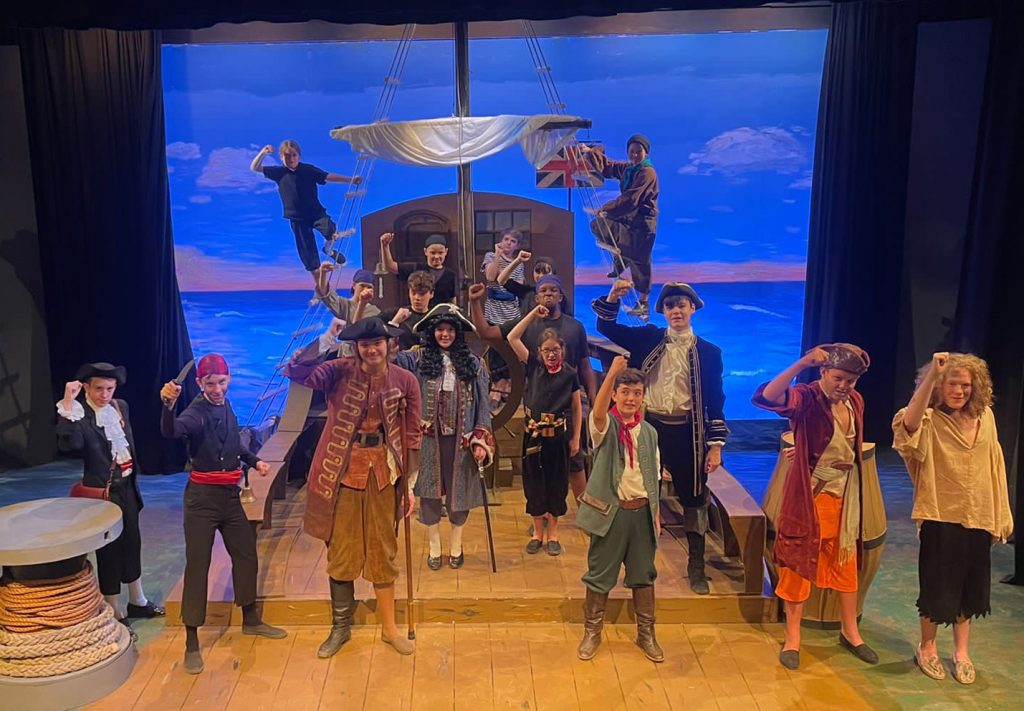
Someone Who’ll Watch Over Me
Reviewed by Julie Cumbo, Artistic Director.
Frank McGuiness’s play, “Someone Who’ll Watch Over Me” was written in 1992 and was a hit both in the West End and on Broadway. Since then, there have been a few revivals and last month saw the latest one, done by the Chipstead Players. The three-hander was inspired by the experiences of Brian Keenan, Terry Waite and John McCarthy who were held captive by associates of Hezbollah in Lebanon in the 1980s. The three captives held in a dank prison are a US doctor called Adam (Chester Stern), an Irish journalist Edward (Jan Kool) and an earnest English academic Michael (David Kay).
When COVID raged and closed all the theatres, the director, Maggie May thought hard and worked diligently to find a play that could be staged within government restrictions once theatres were allowed to reopen. Its minimal set, absence of scene changes and tiny number of props and costumes made this ideal. Given its political context, this is very much a play of its time and yet it is also an exploration of survival strategies and a demonstration of the indomitability of the human spirit. It is perhaps not too strained an analogy to say that, just like these captives, we have all had to adapt, adjust, and find ways of staying sane in the last eighteen months. So not only did the play suit us because it worked within the government’s restraints but also it resonated with audience members who have felt incarcerated for some time.
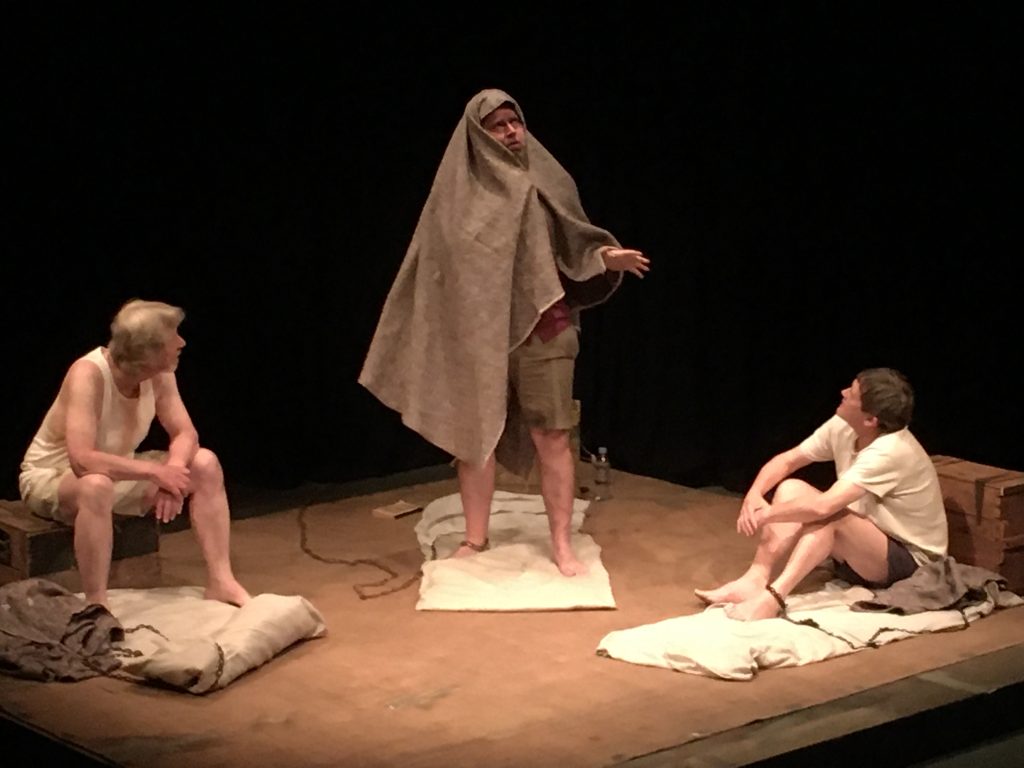
I hope that it is not revealing too many secrets if I say that some people were apprehensive about our putting on this play just after lockdown, fearful that its contents were gloomy and harrowing and not what we needed! In fact, the play has many funny lines and demonstrates the power of the imagination, whether by re-enacting the 1977 Wimbledon women’s final – Come on, Virginia! – or serving imaginary cocktails or flying over land in the Chitty Chitty Bang Bang car. It brings its own light touch to grim matters.
This production had so many setbacks: the dates for the run altered several times and rehearsing was sometimes done outdoors or on Zoom. The director and cast met these challenges with a doughty determination and all three actors, Jan, Chester and David, delivered wonderful performances. Not only was there a huge number of lines to learn but also, with so little movement or action, it was necessary to keep the audience’s interest by changing the pace and intonation. Chester brought out Adam’s unpredictability, staying fit and reading both the Bible and the Koran but sometimes these coping mechanisms were not enough. Jan’s portrayal of Edward showed us a witty, fiery Irishman rather prone to mood swings. The last to join the hostages, David gave to Michael a sensitivity and strength which belied the first impressions he gave as an English repressed killjoy.
Well done to all for producing an excellent piece of theatre in very trying circumstances!
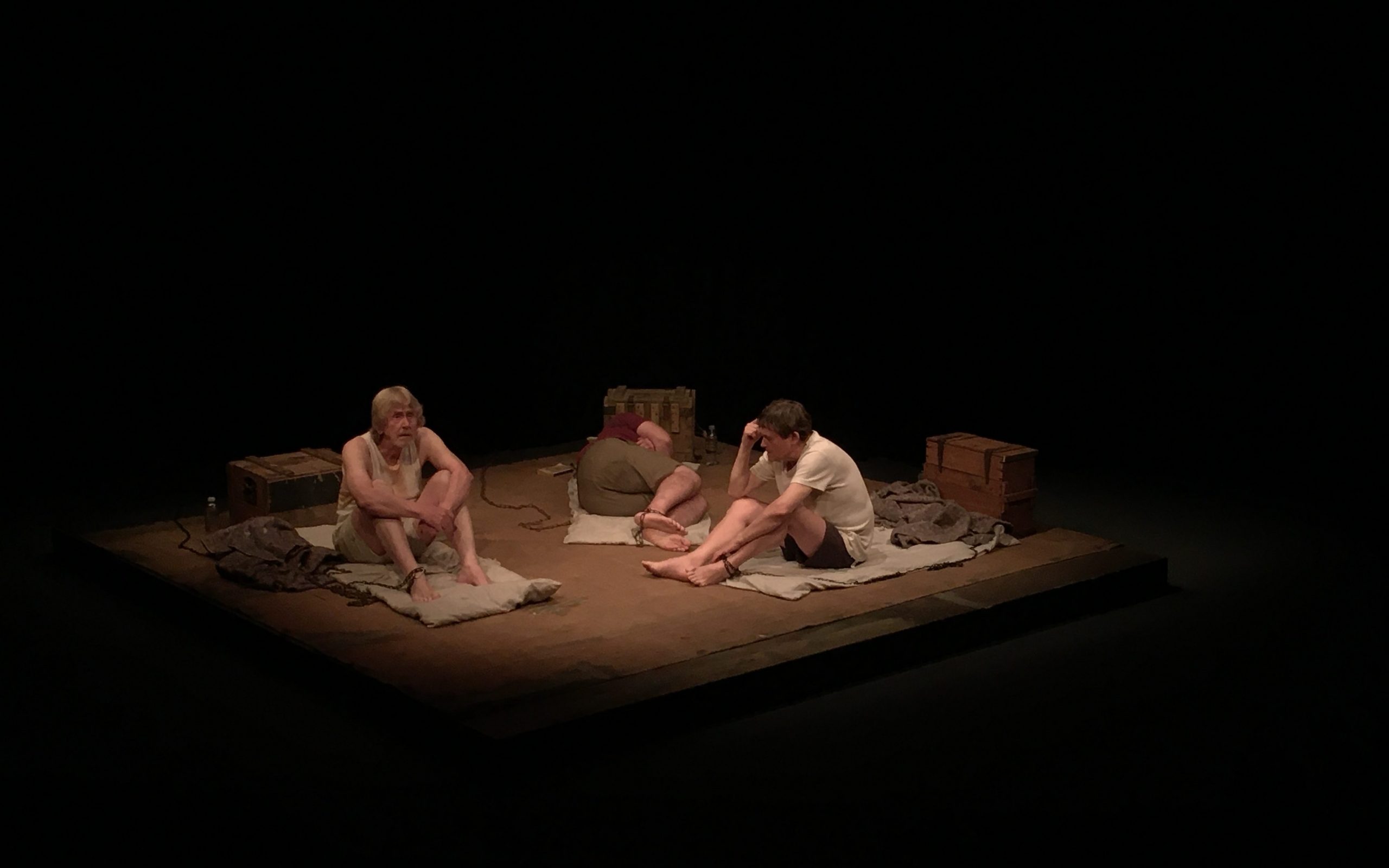
Singing For The Soul
Reviewed by Julie Cumbo, Artistic Director.
The theatre lay forlorn and unused for far too many months but once we lit it up again, it was with an absolute, undisputed triumph! “Singing for the Soul” was a fascinating collection of songs from the musicals: rather than select hackneyed old favourites, the directors chose an alluring assortment of songs, some moving, some humorous and some gorgeous but all of them powerful. There isn’t enough space here to list all the challenges, all the hiccups and all the setbacks that the directors and cast faced since this project started in 2020 but nothing of this was visible in the energetic and accomplished show that appeared on our stage in June 2021.
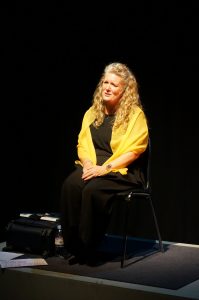
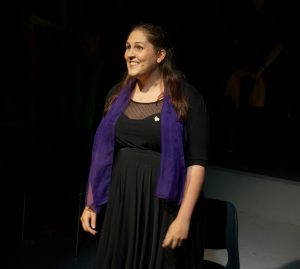
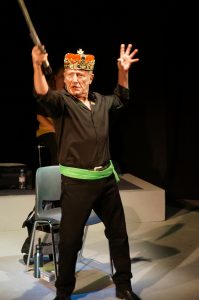
It was evident from watching “Singing for the Soul” how much of our directors’ effort and dedication had gone into it. The songs were sung so beautifully, and the accompanying choreography was so clever, that it was perhaps possible not even to notice the huge amount of care that had gone into working within all the Covid restrictions. There were some ingenious ideas and devices invented by the directors to accommodate the rules.
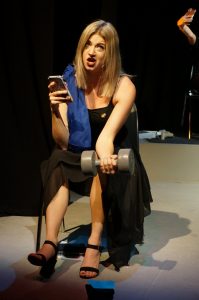

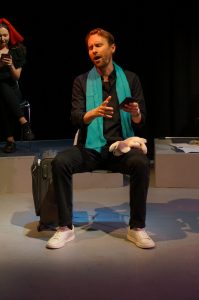
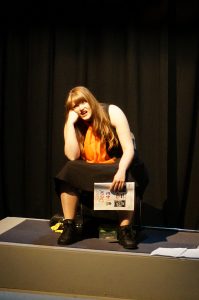
The fantastically-talented cast consisted of Debs Brooks, Frannie Loosley, Jacob Botha, Lucy Vincent, Rick Thompsett and Sarah Marr, all of whom need to be thanked for their resilience as well as for their skill. We’re also grateful to the band which comprised three Brit school students, Cara Joshin, Daniel Fawcett and Fin Millard, all under the control of the wonderful Musical Director, Philippa Lucas. The lighting and sound plots for this production, devised by Jonathan Laverock and John Laws, were both complicated and lengthy. They were ably supported by past society members Ben Gilbert and Fergus Walling. David and Anne Franks, Mags Alexander, Sharon Laws and Britt Adams all played their parts in producing this very successful show.
Finally, though, it’s with boundless praise that I thank the Siobhans because, without them, this show simply couldn’t have happened. Siobhan Walker and Siobhan James thought of it, suggested it to us, nurtured it and persevered with it despite everything that Covid and the government could throw at them. Their verve, resolve and creativity deserve our unstinting gratitude.
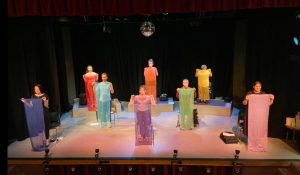
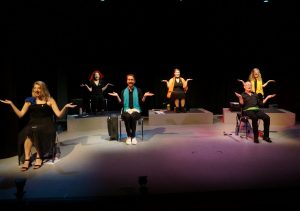
The Hothouse Review
Reviewed by Theo Spring 27th February 2020
The Hothouse – a conundrum? An enigma? A paradox? As the playwright is Pinter, it is more likely that the play is a riddle to be solved – but which may well have different interpretations by different people. The programme denotes the period (a time in the 1960s) and explains the rooms. It does not tell you anything about the building these rooms are in. We do know it is Christmas Day.
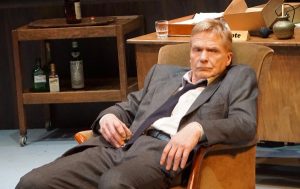 The play opened with an often comic conversation between the head of the ‘enterprise’ and his subordinate Gibbs, who must never fail to address him as Sir. Mel Morgan, in charge as Roote, delivered the gamut of personality from being the boss, to anger, frustration, flirtation and a major reaction to the heat in his office – hence at least one reason for the play’s title. Undermining Roote, all the time, with an obsequious oiliness of which both Uriah Heep and Jeeves would have been proud, Nick Foster kept Gibbs’ secrets and knowledge just under the surface, with an evil, coated in politeness, sometimes slyly revealing itself.
The play opened with an often comic conversation between the head of the ‘enterprise’ and his subordinate Gibbs, who must never fail to address him as Sir. Mel Morgan, in charge as Roote, delivered the gamut of personality from being the boss, to anger, frustration, flirtation and a major reaction to the heat in his office – hence at least one reason for the play’s title. Undermining Roote, all the time, with an obsequious oiliness of which both Uriah Heep and Jeeves would have been proud, Nick Foster kept Gibbs’ secrets and knowledge just under the surface, with an evil, coated in politeness, sometimes slyly revealing itself.
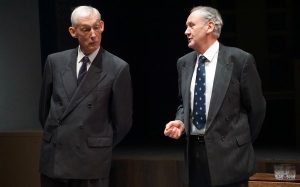
Let’s agree that we are in some kind of an institution. There are references to patients, and sometimes their cries of anguish are heard. On the staff with the sole responsibility of locking all doors and letting no-one in, the hapless Lamb was subjected to what amounts to psychological as well as white noise anguish and he, it transpired, was eventually the scapegoat father of an inmate’s new baby boy. My mind raced over the possibility of pairing the, initially, unknown father with the birth of a boy on Christmas Day, but that was really outpintering Pinter!
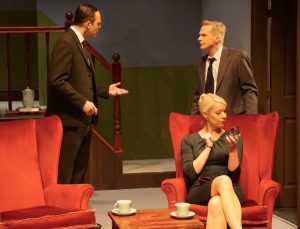 Scott Latham’s jolly, gung ho, slightly puzzled Lamb kept him buoyant even through what amounted to torture. Pinter aptly naming the character to be a lamb to the slaughter. With the same idea, Neil Black brought Lush to life. Subordinate to Roote, his body language and conversation spoke otherwise, revealing a knowledge and distain for his superior whilst also achieving a knowing conspiracy with Gibbs.
Scott Latham’s jolly, gung ho, slightly puzzled Lamb kept him buoyant even through what amounted to torture. Pinter aptly naming the character to be a lamb to the slaughter. With the same idea, Neil Black brought Lush to life. Subordinate to Roote, his body language and conversation spoke otherwise, revealing a knowledge and distain for his superior whilst also achieving a knowing conspiracy with Gibbs.
Add to the scene a Mistress for Roote – Laura Worley as the fickle femme fatale Miss Cutts, who bestowed her favours where they could be to her best advantage.
Contrasts are underlined by the menacing institutionalisation inferred, against the handyman Tubb – played for normality by Nick Gane- who appeared in the office with a Christmas cake gift for Roote together with a request for him to broadcast a Christmas message to the patents, the staff and the understaff. A request which sent Roote into a self-doubting spin.
Waiting patiently for his brief appearance at the end of the play, John Shepherd as Lobb had what, at first, is a reasonably normal conversation with Gibbs, who finds it hard to hide his glee in reporting many deaths which have occurred, the cause of which has, strangely, not included him.
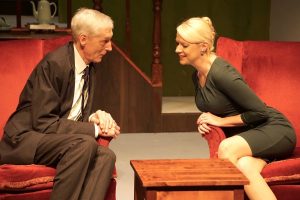 As the curtain went up, Alan Croft’s multi-roomed set offered a reassurance of ordinariness, with its office and adjacent sitting room, yet boded ill with its electrically kitted-out sound proof room with its disturbing lighting by designer and operator James Willis. Props Manager was Mags Alexander who helped to create an air of the era. Just a small thought though – the whisky heavily consumed during Act II had no resemblance to whisky at all, being colourless. A difficult problem to solve when Roote, making a point, kept throwing the liquid in Lush’s face. A hint of a cake icing colourant in the obvious water perhaps?
As the curtain went up, Alan Croft’s multi-roomed set offered a reassurance of ordinariness, with its office and adjacent sitting room, yet boded ill with its electrically kitted-out sound proof room with its disturbing lighting by designer and operator James Willis. Props Manager was Mags Alexander who helped to create an air of the era. Just a small thought though – the whisky heavily consumed during Act II had no resemblance to whisky at all, being colourless. A difficult problem to solve when Roote, making a point, kept throwing the liquid in Lush’s face. A hint of a cake icing colourant in the obvious water perhaps?
So just what did go on within these walls? Who were the patients? We are told they were unable to leave and that one had died. We know they were known by numbers instead of by their names. What we don’t know and never find out, is why they were there, what they had done wrong and, as a further puzzle, why were those in charge forced to work all the time – including Christmas Day?
Chris Hearn directed this quite disturbing play, fortunately enhancing the lighter moments. The music he chose added an apt eeriness and his excellent cast certainly got to grips with the varied characters they portrayed.
Anne of Green Gables Review
Reviewed by Theo Spring 9th January 2020
“If you want my opinion, which I’m sure you don’t” this was a charming piece of theatre with well-drawn characters and good story-telling.
Playwright Sylvia Ashby’s adaptation from the much-loved book used Act I to include many of the important ‘happenings’ in Anne’s life once she arrived at Green Gables straight out of the orphanage and Act II to grow her up, quite fast, through her teens and up to a clever, educated sixteen and a half year old.
Olivia Thynne, in the title role, created an effusive, ebullient fearless young girl who appeared to have swallowed a dictionary, growing into a slightly more sedate, less harum-scarum young lady who coped with both heartbreak and forgiveness as she matured. Hardly off the stage, the delivery of her lines was faultless and her stagecraft was remarkable.
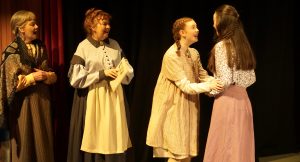
Equally central to the tale of course are brother and sister Mathew and Marilla Cuthbert, who were expecting the boy they requested from the orphanage, only to find it was Anne waiting at the station to be collected. Chester Stern’s Mathew captured the hard-working farmer ingrained with the Canadian accent of the Prince Edward Island setting. Very taken with Anne from their first meeting, a caring, gentle character evolved, albeit with a certain respect for his sister’s plans for Anne’s upbringing. Jenny Bardwell’s Marilla was necessarily harsher and more circumspect regarding, at first, keeping Anne and then trying to tame her imagination. Marilla has her own strict ideas of how people should behave but here I felt that the character could have allowed a little more emotion to colour her words, particularly when told her brother had died, which she seemed to sweep aside without even a crack in her voice. A more gentle side did creep out towards the end of Act II, however.
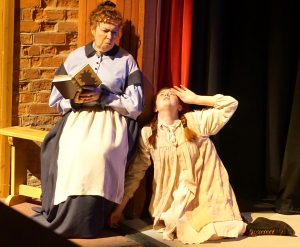
Busybody Rachel Lynde required and got her gossipy meddling from Anne Gregory who brought to life a real nosy parker. Opinionated and threading through the show with one-line advice, a caring neighbour was also revealed and one not too high and mighty to eventually apologise for hurtful accusations.
The play has the merit of a grand selection of further cameo characters. There’s the acerbic, demanding Mrs Blewitt given sourness by Bev Latham; the encouraging and fashionable lady school teacher Miss Stacey – Kate Slingerland – who boosted Anne’s scholastic morale; the less able teacher Mr Phillips – Steven Howell – who had a more self-serving agenda than teaching his class, and Mrs Barry – Susan Marinakis – mother of Anne’s ‘bosom buddy’ Diana, who was too quick to blame Anne for her daughter’s drunken state. Neil Black’s appearance as Mr Spencer was cut short on the first night owing to ill-health and congratulations to Scott Latham, playing the cheery Station Master, who stepped into the role almost instantly, disguising the script within a book and hardly revealing that he was ‘standing in’. A real ‘the show must go on’ moment.
Anne’s young school friends created diverse characters from the shy to the over-confident, from snooty to the doubtful. Edelia Stones became Anne’s trusty confidante as Diana Barry – coping with the alcoholic results of the supposed raspberry cordial with expertise. Charlie McCarthy epitomised the tangled feelings of Gilbert Blythe towards Anne and there was good support from the rest of the class – Jack McCarthy as Moody, Oliver Horle as Charlie, Aoife Jewell as Ruby, Beatrice Houghton as the toffee-nosed Josie and Ethan Simmons as Billy. All of them grew their characters from their younger selves to their older, anxious students and were a credit to to the production.
Linda Hornzee-Jones had designed a beautiful unpretentious set of a kitchen, with stairs up to Anne’s bedroom above and it coped well with all of the changing tale. Costumes by wardrobe mistress Anne Franks were particularly good – all helping to endorse the era and with special praise for those wonderful puffed sleeves!
The choice of country music brought another dimension to the play using, as it did, both sad and cheerful melodies.
Director Ian Brown had pulled together a large cast – each of whom contributed in either a large or small way to the delight of this production, which didn’t disappoint those who fondly remember Anne’s outspoken character and adventures from Lucy Maud Montgomery’s famous books.
The Nether Review
Reviewed by Theo Spring 23rd October 2019
Having been initiated into the power and magic of Minecraft by my grandson, where virtual happenings can be created at the click of a mouse, I could quite comprehend the possibilities encompassed by the ingenious and far-thinking mind of Jennifer Haley who wrote The Nether. The play’s clever title breaks down into ‘the’ ‘net’ and ‘ether’ which just about covered everything necessary for the creation of the play.
Paraphrasing a title from Philip Pullman, the play’s subject material is dark indeed, dealing as it does with paedophilia, although in implication rather than enactment, and its virtual world – The Hideaway – is where ‘guests’ can go to fulfil their fantasies.
As is possible with virtual reality, nothing and no-one is what it and they seem, and clues to solve the identities of the people involved are scattered through the script. In true Aggie fashion, however, these only become clear in hindsight.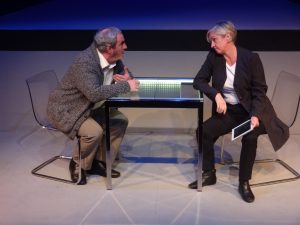
Returning to the real world and the practicalities of delivering seamlessness, where scenes change with rapidity, Linda Hornzee-Jones’ set design set the often-visited Interrogation Room at floor level whilst an amazingly-achieved higher raised stage allowed The Hideaway scenes to take place. Thus, real time and virtual time were physically separated. Back projection created charming and appropriate scenery in The Hideaway and a well-drilled backstage team moved the bed, central to the tale, on and off the stage with creditable precision.
Kirsty Cunnington’s Inspector Morris was feisty and tenacious – worrying at her quarries with alternated gentleness and force, seeking information about The Hideaway and, vitally for her, where its server was based. Facing her questioning, Mike Strong as Mr Sims fought hard to keep his secret personae – that of Papa, the inventor and participator of The Hideaway. His dual personality was so very well envisaged, being a benign ‘uncle’ in The Hideaway but beginning to crack in the real world, under interrogation.
Was it possible to introduce spies into The Hideaway? Michael Rahman as Mr Woodnut was a suspect. Elegantly dressed, he enjoyed the fulfilment of some of his fantasies but baulked at the horrific way he was encouraged to end them. Mr Doyle also had fantasies, giving one of the biggest clues to these at the beginning of his interrogation. But who could unravel what he was saying? John Shepherd’s Doyle was earnest and, by turns both scared of Detective Morris and strongly gainsaying her. The duologue between Doyle and Sims, at the end of the play, was wonderfully executed by both actors.
The subject matter being what it was, there had to be a ‘virtual’ young girl in the cast. Rowan Brown, whom I have seen develop consummate acting skills in her variety of roles at The Courtyard, handled Iris beautifully. Girlish, enticing, but with growing human traits – wanting to be loved – she gave an indication of understanding why she was in The Hideaway whilst remaining charming and giggly.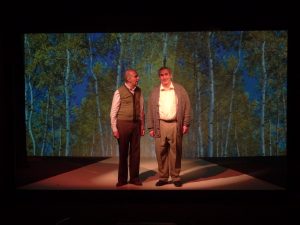
The emotional impact on the cast during both rehearsals and performances for The Nether must have taken quite a toll. Co-directors Sharon Laws and Rick Thompsett deserve huge praise for having the courage to bring such a very difficult play to The Courtyard, for their expertise in helping the cast to deliver it and for sending their audience away with some deep thinking to do about where the internet, in whatever form, is taking us.
The Children Review
Reviewed by Theo Spring 3rd July 2019
In his programme notes, director Michael Rahman suggests this play is “best discussed in the car on the way home. I hope your journey is long enough”. It wasn’t, and the implications, consequences and its myriad inferences are still bubbling.
Author Lucy Kirkwood may have been influenced by the March 2011 tsunami which breached the Fukushima Daiichi nuclear plant in Japan with horrific repercussions. A timely underscore to the current awareness of the ways in which our planet is suffering also had a bearing, and the title encompasses the dilemma of how people with children feel about our world, as opposed to those who do not. The play raises many more points – discuss.
The set, designed by Linda Hornzee-Jones, was a work of art and must have taken John Fitzwater and his construction crew many hours to create. A cottage kitchen with a raised dais for the cooker, a butler’s sink, fridge, cupboards and kitchen paraphernalia, was along the back wall. In the foreground was the kitchen table where most of the action took place. It was at this table that two old friends renewed their acquaintance after 38 years and where Jane Foster as Hazel and Katayoun Thurlow as Rose created what at first seemed a friendly chat, so real did they make their conversation flow. Both are nuclear scientists who worked at the nearby nuclear power station that has suffered a disastrous meltdown.
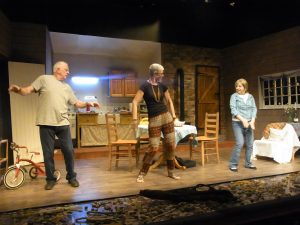
The cottage is outside the dangerous exclusion zone but Hazel and her husband Robin had to leave their farm, which is within it.
Hazel has children. Rose does not, but she is recovering from breast cancer having undergone a double mastectomy, which their ostensibly cosy chat did not reveal.
Interrupting the discussion, which wasn’t all plain sailing, Robin returns from the farm. Warwick Beazley created what, on the surface, was an easy-going man who had also worked at the power station. However, as the play progressed, he revealed much more – as a one-time lover of Rosie and as a keeper of more secrets from his wife. The cows he told her had survived, had not, and his work there was painstakingly burying them.
There are complex conversations over a salad and bread meal, including Hazel haranguing Rose over just what she had done in their toilet when she went out to the loo.
The elephant in the room, however, is why Rose has come to visit them – the reason for which causes a huge upheaval in their lives.
Due to the disaster, electricity is sporadic but, in Act II, lights suddenly burst on in the kitchen and there was enough power for Rose’s laptop. This she tuned in to music, allowing the three of them to hark back to their youth and recapture a dance routine they all once knew, underlying the hope, particularly from Hazel, that life could get back to the way it was – a hope she finds it almost impossible to release.
The complexities of the possible problems in a future world are both explored and left to be imagined. Each member of the cast created a realistic character whose words had ‘wake-up call’ impact but their greatest skill was their ability to be real people within those characters, thus accentuating the impact of the play.
The play ends with lighting designer Jaydun Dervish’s wonderful sea-rippling lighting effect as Hazel resorts to her yoga routine with Rose copying her. As the sea theoretically engulfs the kitchen, it harks back to an earlier conversation about a village which fell into the sea and whose church bells can still, sometimes, be heard ringing. A most effective, if disturbing, end.
Michael Rahman, whose directing debut this was, certainly chose a fascinating and disturbing play, but after all the sadness within it, perhaps I should end on a light-hearted note. Didn’t he do (very) well!
The Keeley Plate 2019
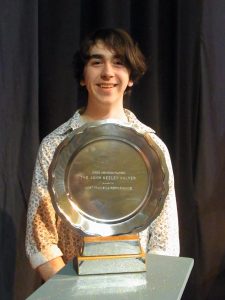
The Keeley Plate 2019
This year, Sue Wheeler and Edwina Marrow joined me on the Keeley Plate committee, both former juniors themselves, with Sue being a contemporary of John Keeley in whose memory this award is presented. We met up earlier this month and I’m going to take about four minutes to relate our discussion.
The 2018/19 season started with a bang. The Sneeze was filled with remarkable performances, it was funny throughout with poignant undertones, especially felt with Jonathan Neary’s portrayal of Vasily Vasilich’s Swan Song. Each member of the ten-strong cast had their chance to shine. This play stood proud on equal footing with the rest of the season, and you won’t have seen the words “Youth Theatre” in the programme. The maturity on show was testimony that it was an appropriate decision to leave it off. Sometimes members shy away from Youth Theatre shows. We tricked them into going! And they would have been so cross if they’d missed it just because of some preconceived notions that they can now put to rest. You’re welcome!
Ethan Elsdon had a commanding presence, more mustard anyone? The Sneeze segment itself was so funny. Largely without words it was a masterclass of facial expressions and mime. Ethan was terrifying. Kate Batcheler hilarious.
One of the highlights of the whole season was Simon Perry’s Nyukhin in The Evils of Tobacco. It takes a certain amount of bravery to take to the stage on your own to deliver a really lengthy monologue. In front of the tabs too. Nothing much to hide behind, nearly in the laps of the front row. Though alone, he peppered the stage with the characters he was discussing – we could ‘see’ his wife. It had moments of light and shade, calmness and distress. Truly memorable.
Next was Wendy and Peter Pan. We saw Simon Perry again moving confidently about the stage. Josie Cunnington shone as Tiger Lily despite the relatively small part. Ethan Simmons is developing well, and Jack Randall was just adorable as Tom Darling. A role he shared with Martha Brown. The Keeley Committee members staggered our nights so we were able to see them both.
Jonathan Neary was amazing in The Ladykillers. And speaking of Ladykillers, Jaydun Dervish and Lewis Gonyou appeared on stage in full costume and make up to take their place amongst a rabble of old ladies for a few of the performances and we’re so glad they did because it gives us a chance to mention them. Jaydun has been involved in lighting nearly all the shows this season, and Lewis enthusiastically supports the sound. They busy themselves backstage where there’s little glory but they’ve been committed to the theatre this season, and as youth theatre members we’re happy to mention them.
Kiara Kaspersen as ‘Emil’ in Emil and the Detectives showed wonderful promise, able to cope with so many lines while hardly leaving the stage at all. Charlie McCarthy gave a very good character performance, playing against type we’re assured. And Emma Goulden stole the show. We have to keep our eye on that one. Louie Easton, though disguised, was memorable in his dastardly moustache. Stealing from a child – the swine! Connie Williams projected really well and Rachel Ekins, so young, stamping across the stage. She didn’t have much to do, but when she did she certainly made the most of it.
A great season for our young ones. This year, for all the reasons mentioned, we are delighted to award the Keeley Plate to – Simon Perry.
The Dark Earth and the Light Sky
Review
Reviewed by Theo Spring 20th May 2019
Written by Nick Dear, I wonder how many of the audience, like me, were being introduced to the poet Edward Thomas for the first time. A troubled soul, for many years he earned his living as a reviewer and writer of travel books before an opportune meeting with the American poet Robert Frost unleashed his poetic oeuvre.
Thomas’s love of nature was beautifully reflected in the set with its bucolic backdrop of green rolling hills stage right and the enviable use of a revolve allowing for three separate places in Thomas’s life to be staged. Sarah Chadwick contributed the ground row of World War I battlefield artwork, so slickly later removed by the backstage crew.
There are many moody moments during the play with a timeline and setting which hopped about a little with emotionally-delivered soliloquies helping to anchor both the time and place.
Thomas was, it appeared, a reluctant family man with a lively, spirited wife and three children but, the play impresses, his happiest times appeared to be when tramping the woods with his deep-thinking friend Robert Frost. Creating the multi-faceted character of Thomas, Dan Jewell portrayed his angst, his disbelief in himself, his varying emotions and, ultimately, his unexplained death wish which sent him to the front line which he could, had he so chosen, have legitimately avoided. At ease when walking with Frost, uptight when being berated by his disappointed father who later became the proud parent when Thomas put on uniform, he found it difficult to be a family man.
An unfailing American accent was required of Nick Foster as Robert Frost – achieved without fail and with Frost’s friendship, advice, and encouragement for Edward all clearly recognised. Foster’s ability to establish the firm friendship and affection Frost had for Thomas was established early on in the play and, as part of the true story, much of the 143 poems that Thomas finally wrote between 1914 and his death on the battlefield at Arras in 1917 were due to Frost’s belief in his friend’s untapped abilities.
There were two women who loved Thomas deeply. First his wife, Helen, to whom Hope Elsdon brought both stoic care of her family mixed with a gaiety and deep affection for a husband whom she found it quite difficult to understand at times. Elsdon’s charming delivery of her songs and some lively elegant dancing brought lighter moments to the play.
Eleanor Farjeon’s name in poetic circles is more familiar. Alison Sheppard made her friendly to both Helen and Edward Thomas, trying unsuccessfully to hide her feelings of love for Edward and delivering a most moving speech, from a cocktail party much later in the timeline. The picnic scene with drinks and lighted lamps when all four of these characters are together was memorable.
As Thomas’s rather bullying father Philip Thomas, Geoff Thorn established his disappointments at Thomas’s failures and life choices, initially changing his attitude markedly when his son enlisted. Bombastic and stern, Thorn made it clear that there had never been a father/son relationship.
Laurence Read took the cameo role of Major Lushington, appearing briefly to, again, explain to Thomas that he did not need to go to the front line, whilst Neil Black’s cameo was of a threatening angry farmer, anxious to get Frost and Thomas off his land.
All the costumes were carefully selected by wardrobe mistress Lorraine Bygraves and her team to be apt for the period, with special mention for the army uniforms complete with puttees and army boots. Lighting and sound played an important part in the production with Brian List and Ian Grayson respectively designing. The artful set already mentioned was designed by Geoff Dunstan.
Directed with great empathy and an understanding of her characters, Anne Page opened and closed the production with Vaughan Williams’ A Lark Ascending, so clearly setting the scene for this unusual play.
Emil and the Detectives Review
Reviewed by Theo Spring 13th April 2019
Alan Croft’s uncluttered set design enabled the many scene changes required in this production to use the audience’s imagination, allowing them to be so speedily accomplished that the pace of the show was never under threat.
Marshalling a cast of 18 young players, of whom the youngest was six, was no easy task but throughout all the speedy comings and goings demanded by the show, never once did any of the cast look as if they were not sure of where to be or where to go next. The perfect result of good rehearsals, attention to detail and a cast who take direction on board.
Based on the original children’s story by Erick Kâstner, there is plenty of scope for a large cast in playwright Carl Miller’s adaptation. First glance at the programme looked a little baffling with some of the cast playing many roles, but all became clear as the faces became more familiar, albeit that the characterisations were excellently varied. In a nutshell, young boy Emil Tischbein is trusted with a large amount of his mother’s savings to take to his grandmother in Berlin. He is robbed on the train journey there, arriving penniless in Berlin. Determined to recover his money he meets a group of children who decide to become detectives and help him. The tale is of their adventure, their battle against the adult world and, (spoiler alert) how they finally succeed to reclaim the money.
Almost permanently on stage, eleven year old Kiara Kaspersen took the role of Emil in her stride, using acting skills beyond years and speaking clearly to enable the plot to be easily followed. Lauren Woods played ‘his’ mother, Mrs Tischbein, showing maternal concern about sending her young boy off to the big city of Berlin on his own. In her role as the Newspaper Woman she was central to the children’s plan to apprehend the thief To Rowan Brown fell the excellently accomplished task of being a bent and rather grumpy Grandma who, in the final moments, transformed into a lively lady wanting to join in the children’s next adventure.
The detectives themselves each had their own abilities, hang-ups and strengths. Charlie McCarthy’s Professor was thoughtfully spoken, seeing pitfalls and having ideas whilst Theo McCarthy’s Petzold brought enthusiasm and impetuousness to the detective’s plans. Once calculated and agreed, the plans needed someone with a telephone at home and Jacob Gower as Tuesday grudgingly took on this task but became a pivotal part of the plan, his excitement growing as the phone kept ringing with sightings of the thief. It was Jack McCarthy as Toots who first befriended the frustrated Emil who had tracked the thief down to a restaurant, but was powerless on his own to act. Toots gathered his friends to the cause and thus the detective group was formed. Within this group were Edelia Stones as Hilde and Jack Randall as Arnie with Ava McCarthy and Martha Brown helping as the Silent Twins, Irene and Liesl. Following the thief to his hotel, the children were able to enlist help from inside with Ela McCarthy as Gerda. Always supporting the plan to recover the money was Emil’s cousin Pony the Hat. Emma Gouldon,at only eight, certainly made her mark with enthusiasm and a good share of the script but her lines needed to be delivered a little more slowly. She was, however, a real live wire.
And the cause of all this sleuthing? The wicked Mr Snow who had stolen Emil’s money during the train ride to Berlin. Louie Easton gave both gravity and insouciance to the role, working particularly well in the scene in his hotel room.
As mentioned, players took many roles and Connie Williams as a strident Mrs Wirth, Sam Gower, Rachael Ekins, Oliver Horle and Ethan Simmons appeared in many guises throughout the production.
Directors were mother and daughter Debra and Hope Elsdon who must have had many a long conversation over tea or maybe something stronger, as to how to bring this busy production to the stage. This they did with great success which was underlined and certainly helped by the obvious fact that the children were thoroughly enjoying themselves.
The Ladykillers Review
Reviewed by Theo Spring 28th February 2019
This delightful version of the Ealing Comedy film, turned into a play by Graham Linehan, has been a popular choice in the locality – this was my third invitation to review it – and each one has been very different. Directors Lauren Millsom and Noel Harris may just care to know that I consider theirs the best!
The set requires a kitchen, hallway, sitting room, upper room, a large cupboard, loo and a window with egress. Oh, and an indication that the house wherein the play takes place is built within a hair’s breadth of Kings Cross Station in London.
The scene was set even before curtain up with videos of trains, platforms, ticket inspectors and the like, all appropriate to 1956 when the play is set. Full marks go to Mark Neary listed for Special Effects for, at the end of the play, the very clever footage of a train approaching the final villain the piece (all the others having met a variety of ends) and finding him on the tracks without hope of escape.
Judging by the popularity shown through a sell-out here, most people will be familiar with the story of robbers, masquerading as musicians, who rent an upper room close to Kings Cross where they plan their heist under the guise of practicing their ‘art’.
‘Professor’ Marcus is the brains behind the plan and he has called in a team of villains to help him steal a large amount of money, transported in a trunk to Kings Cross. Nick Foster got right beneath the professor’s skin making him charming to his landlady, patient with his team – especially the really dumb one included for his brawn – and quick-witted, with the many times the professor had to think on his feet to rescue the tumble of situations which could rumble the plan. Costumed in the longest scarf I have ever seen (a labour of love knitted by Lewis Wilmott), he wears it constantly and it has its own comedy role. Each of the ‘musicians’ is reassigned a new name and history. Thus we met ‘Major’ Courtney with his fictional war history who has an affection for ladies’ dresses and, in Mike Strong’s hands, is a gentle soul. Completely the opposite is Louie Harvey, a mean Eastern European with a twitchy knife hand. David Kay is certainly threatening in the role but tempers it by eating his constant supply of jelly babies from his knife point. Joining the robbers is Harry Robinson who has a cleaning fetish and a quick eye for nickable silverware. Jonathan Neary brought young Harry to life, dealing well with Harry’s instruction to smother their landlady – which he couldn’t bring himself to do. To the scarf knitter – Lewis Wilmott, fell the comic role of ‘Mr Lawson’ real name One-Round. Dozy, forever getting his pseudonym and the robbers’ story wrong he seemed to develop much affection for the cello he was assigned to pretend to play.
Each member of the gang had different feelings for their landlady, the not-so-daft Mrs Wilberforce, exceptionally well brought to life by Jan Robinson as a little old lady, sometimes confused, but whose morals were above reproach.
Phil Wright was the patient policeman who dealt with Mrs Wilberforce’s concerns about criminality, Susie Timms was Mrs Tromleyton who headed up the assorted guests at the concert the gang were forced to give and Mags Alexander squawked effectively as the poorly, caged bird, General Gordon.
The clever set, encompassing all the venues already listed, was designed by David Franks and the all-important projection work was fulfilled by Stephen Thurlow.
Mags Alexander and Cathy Goode deserve praise for supplying props which had to include all those vital musical instruments, and Wardrobe Mistress Lorraine Bygraves kept all the costumes relevant to the era.
Many additional touches added to this well-rehearsed production, like the blackboard which always delivered a small blow to poor Harry when turned over from the geography of the ‘plan’ to the musical score, the hair-raising shuffle along the ledge outside the window with the train tracks below, Harry’s constantly groomed hair, and many more.
Altogether, the show was a triumph for its co-directors Lauren Milson and Noel Harris and the hard work by absolutely everyone involved.
Wendy and Peter Pan – Review
Reviewed by Theo Spring 18th January 2019
What a delight. This whole production had so much going for it – a familiar story
(with adjustments), goodies, baddies, great staging, a wonderful mix of superb young
and adult actors and meticulous direction by Debs Brooks.
Playwright Ella Hickson had moved the emphasis of J.M. Barrie’s original to
empower the females of the tale, thus giving prominence to Wendy, Tink and Tiger
Lily, with an additional hurrah for Mrs Darling who joined the Suffragettes. The
director chose to add to this by casting Sharon Laws as a fearsome Hook, totally in
control of her motley crew of pirates.
The flight to Neverland is necessary because an additional Darling – Tom, is poorly
and taken off to be a lost boy by Peter Pan. He visits the nursery again and it is
Wendy who wakes brothers John and Michael to go with her to find the missing
Tom.
Rowan Brown wasn’t fazed at all by the huge role of Wendy, giving her urgency,
anger, empathy and caring by turns, delivering a superb performance throughout.
Simon Perry’s Peter matched her equally well and there were some charming
moments between them. As the young Tom Darling, Jack Randall stole hearts in
scene one and didn’t reappear until nearly the end of the story, sharing his
performances with Martha Brown. John and Michael were very much involved
however with Connor Cecil in his signature top hat commanding as John and Ethan
Simmons ecologically aware as the much more gentle Michael.
Kirsty Cunnington and Philip Brooks quibbled considerably with each other as Mrs
and Mr Darling and Nana was one of the characters not included in this retelling.
In a play where most spoke well (Pirates excluded), Sofia Nicodemo’s Tink was
cockney, down to earth and ‘well good’. Her dislike of rival Wendy kept her playing
tricks and her lines were peppered with modern catch-phrases – a most un-Barrie
like ‘”Bog off” came from both an adult and Tink.
The lost boys were an excellent team, some named for their clothing like Georgina
Perry’s Pockets. Oliver Horle’s Curly had a mop of very straight hair and Tootles
(Edelia Stones) Nibs (Charlie McCarthy) and Slightly (Connie Williams) aided the
action and lauded their leader, Peter.
Hook’s team were far less charming. Scott Latham was ever there to do his
Captain’s bidding as Smee and Jon Laws made Doc Swain a vicious pirate. Rick
Thompsett gave Knock-Bone Jones an evil air and Bev Davies brought a little
glamour to the villains with her colourful costume, first as Skylights then as a
pirate.
Opposite each other in temperament, Bradley Adams was a comfort as Martin the
Cabin Boy whilst Josie Cunnington’s Tiger Lily was both feisty and forgiving – a
friend to the last. Then, of course, there was that threatening, clock-ticking
crocodile, artistically envisaged here, with actor Krissi Perry saying not a word but
always looking malevolent.
Beautifully coated, with a swagger and a metallic hand to the fore, Sharon Laws
truly encompassed evil as Hook – ever seeking the truth of Peter’s eternal youth and
ever out to kill him – a masterful performance.
To Janet Bennett go huge praise for the ingenious set with its almost Narnia-like
wardrobe and the beautifully painted Neverland jungle by Andy Pitman and his
construction team. With the young actors leaping about, on boxes, beds, windows
and through trees, the set didn’t even tremble. An additional delight were the
twinkling string of lights in the auditorium, energised by the hands put together to
revive Tink because, of course, everyone in the theatre truly did believe in fairies.
Hook’s pirate boat was another triumph, moving smoothly onto the stage to give
Hook the upper hand (?) in one of the well-staged sword fights.
Costumes were demanding and helped conjure up the story, with hard work from
Anne Franks and Roz Hayes. Kirsty Hudson added her considerable skills as
choreographer.
An uplifting and happy show – very many congratulations to everyone involved, with
a happy audience leaving to seek the second star to the right and straight on ‘til
morning.
Trap for a Lonely Man – Review
Reviewed by Theo Spring 24th October 2018
Reviewing a play at the very start of its run is maybe a little unfair, but here Act I was a little slow and some of the cast a little hesitant on their lines, but all this would surely improve as the run progressed.
Set in a chalet near Chamonix in France, the huge mountain backdrop by Sarah Chadwick was most impressive and brought a whiff of mountain air into Geoff Dunstan’s set, with its wooden walls and comfy seating. Large double doors leading out from the sitting room were the main entrance and exit for everyone and a cheerful fire burnt in the fireplace. A silly but real niggle for me was the number of times those doors were left wide open when the fire was on, letting in all that chill air – or am I being too practical?
To enhance the enigma, none of the actual characters are given names in the programme – thus we meet The Man, The Priest, The Woman etc. We do learn their names as they converse, but are they all who those names say they are?
Daniel Corban, The Man, is the central figure in a psychological drama full of subterfuge from every single character, with a ripple of truly unexpected twists at the end. Lewis Wilmott’s Corban was earnest, frustrated and demanding as he constantly badgered the police to find his newly-married wife Elizabeth who had not come home for days. In total contrast, Geoff Thorn as The Police Inspector, was sanguine, unflappable and seemingly always able to come, when telephoned, at a moment’s notice. The initial setting up of the plot in Act I is demanding on both The Man and The Police Inspector and their interactions increased in pace as the play progressed.
Beautifully costumed, complete with flat hat, Phil Wright as The Priest arrived at the Chalet to thank the man’s wife for her generous contribution to the church. Believable as a religious man with an air of amiability the priest brings comfort to Monsieur Corban. He is happy to reunite husband and wife after what had been a fierce argument, but as he brings her in through those doors, Corban vehemently denies she is his wife. Laura Worley (The Woman) exudes affection and concern for Corban. She knows what’s in the fridge, she knows how the heating works, so is she Elizabeth? Who is lying/confused?
In the main, it is down to these four characters to weave and develop the plot, which wriggles and winds, and it is vital to concentrate to appreciate the skill of playwright Robert Thomas.
New visitors arrive at the Chalet. Noel Harris’s wonderfully scruffy, grubby, itchy and imbibing tramp rather stole the show, even with his brief time on stage whilst Susie Timms in an equally brief appearance as The Nurse made her mark with vigour and a raised voice.
Again, superbly costumed, Don Hindle as The Policeman had just a line or two but is constantly present with his Inspector, although in the background or ‘just outside the doors’.
As already mentioned, wardrobe mistress Anne Franks delivered some great costumes, although the shrug for The Women over her certainly mid-60s dress was out of its time. Movement flowed easily around the stage, particularly when many were present.
Under the direction of Will Harris, the cast most certainly built up the air of intrigue and, during the interval, there were many different suggestions of what would happen next. I doubt however, that anyone guessed how it would end – a thriller – most certainly, but a clever and very well delivered ending.
The Sneeze – Review
Reviewed by Theo Spring 4th September 2018
The upper age group of the Youth Theatre brought a high class selection of comic tales by Anton Chekhov to the stage, proving, as the programme notes point out, that the maestro is not all tears and unhappy endings.
Many of the cast were involved in more than one of the eight tales and thus had to reinvent themselves into entirely different characters. Henry Barriball playing a servant, twice, and a cart driver, turned himself from the OTT gay manservant Luka – really comic – to the Jeeves footman in The Alien Corn – all straight face and “ no, sir”, to the chatty ‘cab driver’ carter relaying gossip. The scenery for the cart ride, pulled through a leafy lane by a horse, was very cleverly done. Shame the patient horse went uncredited in the programme!
Oliver Griffin brought justifiable ennui to Pavel Vasilyevich, forced to watch as a ‘fan’ enacted her rather awful play to him – playing all the roles, but as a landowner in The Proposal his character was full of vigour and ire as he vacillated between the relief of offloading his mature daughter in marriage to arguing the rights of land ownership with the swain.
Not taking ‘no’ for an answer, Emily Foster’s Murashkina enforced the writer she admired to watch her play – all five acts, admirably including diverse characters. Far more sedentary and elegant was her silent role as the wife of the Government official in The Sneeze.
Upper class every time, Ethan Elsdon’s multiple roles as a Government official, a traveller and the most amusing landowner Smirnov in The Bear were diverse characters. Setting out to bully a widow whose husband owed him money this role required mercurial changes – from demanding to wooing – all so well accomplished.
Insecurity by Toby Maynard were required for both Champugne whose French accent was well sustained as the mocked tutor in The Alien Corn and Nikita the lowly prompter in Swan Song. Both roles delivered with the emotions eminently suitable for the characters.
Exchanging the spotlight and applause to become a non-entity, Jonathan Neary as an actor Vasily Vasilich was loathe to let go after his farewell bash. Theatrical to the core and delivering Lear’s “Blow wind and crack your cheeks” fury to prove that even at 68 he could still act, there was determination alongside the pathos in Swan Song. Completely opposite this highly verbal role, in The Sneeze his expertise fell to mime only and the whole silent group on stage ‘told’ the entire story clearly. Kate Batcheler aided this story as Vasily’s wife, full of apologies and explanations when her husband’s sneeze caused such silent uproar. She created a loyal housekeeper – Olga – in The Bear, always with the interests of her mistress at heart. Maria Gallagher as that mistress – a widow – combined initial fury at Smirnov’s financial demands before finally succumbing, as he had, to their inevitable attraction.
The mature daughter standing up for the family’s ownership of land in The Proposal gave Mia Kelly as Natalya, the chance to be headstrong, angry and a coquette – all of which she ably accomplished. Arguing the possession of the Oxen Meadows which adjoin both her father’s and her neighbour’s properties she is unaware that the neighbour, Ivan, has come to propose to her. Simon Perry’s Ivan combined fury over the possession of the Meadows and the later comparison of their working dogs brought on his long-suffered ill health, all revealed in great style. But it was Simon Perry’s Nyukhin, delivering a solo lecture in The Evils of Tobacco, which frequently revealed his marital unhappiness and his battle axe of a wife which impressed, as he held the stage and endeared himself to the audience to open Act II.
All eight plays were given professionalism and drama by their various casts, making a delightful whole. Costumes by Lorraine Bygraves and Maggie Porter enhanced both the era and the country, as did the Russian music chosen to cover scene changes. The reminder to turn off mobiles was impeccably delivered – in Russian!
The directing team of Jane and Nick Foster certainly picked a winner for their talented cast to perform and the seamlessness of the plays, which flowed so well, were proof of much hard work by all concerned. All the audience had to do was sit back and thoroughly enjoy these varied and amusing comedies.
The Keeley Plate 2018
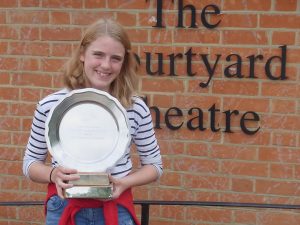
The Keeley Plate committee were so happy to get together recently to discuss another truly exceptional year for our Youth Theatre. The quality we’ve seen confirms there really is no “them and us” when it comes to what our young ones bring to the stage, every play in the season has equal value. If you miss one you miss out!
As always we consider all qualifying plays from the last AGM until now, that is from Streetcar to now. The qualifying plays were Mugged, Taking Breath, Splendour, The Scary Secrets of Septimus Sloane, Rules For Living, The Ash Girl and The Diary of Anne Frank. So that’s the whole of this season so far!
We were delighted to see so many Youth Theatre members in so called ‘Adult Plays’. Cast your mind back to how Katie Bignell held her own in the four-hander that was Splendour – by all accounts a technically challenging play. We also saw Maria Gallagher in Rules for Living and Henry Barriball, Rowan Brown and Vicki Bailey in The Diary of Anne Frank.
We always look forward to the first plays of the season to see what our older youth have in store for us. Jonathan Neary was so memorable and Ben Jeffreys surprised us with a fresh new character. Toby Maynard and Tara Baker stood out too. Emily Foster, Alfie Earl Day and Kate Batcheler were Taking Breath away from audiences and Gemma Bottomley is one to watch. We hope to see more of you next season.
With such a large cast in Septimus the wonderful singing of Maria Gallagher, Tara Baker and Olivia Thynne enabled them to stand out. As did Rowan Brown and Bradley Adams.
When we started to think about the Ash Girl we were singling out name after name after name until we realised we had gone through the whole cast. When analysing it we discerned that it was the groups that worked together so well. The ‘Sins’, the little animals, the sisters and step mother, the Royals, it was such a brilliant play, dark and different, they played it so sensitively, the Chipstead Players are lucky to have them all among our ranks. Then of course in Anne Frank we had stand out performances from Henry Barriball, Vicky Bailey and Rowan Brown.
When thinking about awarding the Keeley Plate four people stood out to us.
Henry Barriball – The lethargic slothworm who really made the most of his amusing lines in The Ash Girl, but it was his role as Peter in The Diary of Anne Frank where he stood out. The play covers a number of years and it required him to show us character development as his outlook changed over time. A difficult role.
Rowan Brown – has such confidence, and she gives the audience confidence, it’s like we feel we’re in safe hands. In Septimus she showed that she truly understood her lines. In the Ash Girl and Anne Frank (two title roles) she had a deep rooted connection to what she was talking about and was emotionally intelligent.
Maria Gallagher – was strong throughout the season, had good stage presence, sang with confidence and really took charge in Septimus. And in Rules For Living she enters the stage at an intense moment and holds her own with a powerful monologue amid the carnage.
Vicky Bailey – has been a mature presence throughout the season, but particularly impressed us in Anne Frank. The role required an understated performance which can be a real challenge, she was the perfect foil to the boisterous Anne. Vicki showed great attention to detail, poise and gracefulness.
We wanted to mention you four in particular and are delighted to award the Keeley Plate this year to – Rowan Brown.
Time of My Life – Review
By Theo Spring 14th July 2018
The Italian restaurant setting, designed by Sarah Chadwick, where all the Stratton family events and problems were revealed, was most convincing. One of its notable achievements were the very functional and perfectly working swing doors out to the kitchen – a feather in the cap of Andy Pitman and his construction crew.
First performed in 1992, playwright Alan Ayckbourn enlarged on an idea used in one of his previous short plays – Between Mouthfuls – from his 1974 Confusions quintet. Its restaurant setting hosted couples with varying problems which were only overheard by the waiter as he drew near to their table, and it all took place on the same evening. In Time Of My Life, there are three tables and three time zones; the present, the past and the future, cleverly allowing the audience to know what was coming whilst listening to table talk set in the past.
It is Laura’s 54th birthday and her husband, two sons, her daughter-in-law and a girlfriend celebrate in Essa de Calvi, the restaurant they have patronised over many years. As it is ‘the present’ the characterisations show no signs of the way they will change and what they were before this party. It is Phillipa Lucas as Stephanie, the daughter-in-law, who evolves from mouse at the party to masterful, and it is only discovering later what she will eventually become that gives appreciation of her initial shyness. Her husband is the brash eldest son Glyn who works with his father and is a womaniser.
Philip Brooks gave Glyn the pathos of believing his mother did not love him at all and sincerity when pacifying his wife that all was well with their marriage. Bumptious and self-centered he is not even that thrilled to learn his second child is on the way. Younger son Adam is his mother’s favourite and, with his girlfriend Maureen, provides much of the comedy. Joe Ackerman and Debs Brooks play the pair – he a little shy and reluctant and she a blousy hairdresser who does her best to conform to what she believes are his and his family’s ideals. Her costumes and wigs were a triumph of contrast and I loved the bright colours worn for her blind date which, she believed, were ‘dressing down’. The three wardrobe mistresses responsible for the many changes of costumes – Lorraine Bygraves, Margaret Ramsdale and Margaret Palmer certainly had their work cut out.
The restaurant’s tables are the centrally placed large one for the main party and two smaller ones placed downstage. It is at these, at different times, where the happenings in the lives of both Adam and Maureen, downstage left and Glyn and Stephanie, downstage right, were revealed.
Paying the bill for the party, father Gerry tries to keep everyone happy, pandering to his wife so she enjoys her celebration and initially keeping quiet about his business worries. Mel Morgan transforms Gerry’s personality through the evening being mine host and a furious cuckolded husband are just a few required of his character. The programme notes reveal him to have designed the amazing set for Chipstead’s The Diary of Anne Frank so, obviously, a man of much talent. Playing the birthday ‘girl’ Laura, Kate Perry exudes the matriarch who is in charge overall. A snob, she dislikes the ‘common’ girlfriend Maureen along with the gift of earrings given to her by Stephanie. Effusive in her praise for the jewellery, she manages to make it clear she hates them. On stage at the central table for most of the play, it is evident who has caused the considerable dysfunctionality of the family.
Most Italian restaurants have a ‘character’ either in the kitchen or as a waiter. Noel Harris brought huge comedy playing four of the staff who had come and gone over the period of the play. His cod Italian accent got laughs as did his body language when a waiter. His quick changes kept the pace going and helped root the scene in its time zone.
As Calvinu, the owner of the restaurant and long-time friend of the Strattons, Don Hindle presided in avuncular fashion, treating Gerry and Laura to the alcoholic beverage that caused revealing mayhem.
Director Eve Manghani’s ability to assist the cast to establish such different personae in the different time frames enhanced a production which was, although a little long, certainly very much enjoyed.
The Diary of Anne Frank – Review
By Theo Spring – 21st May 2018
It was bound to be emotional considering the subject but directors Sharon Laws and Rick Thompsett brought out so much more, considerably aided by a talented cast and the two playwrights, Frances Goodrich and Albert Hackett, who envisaged the years eight people spent in hiding, including two young people growing up, and the overall fear of discovery which pervaded their lives.
Mel Morgan’s set design was a triumph and interestingly gave the Franks more central living space than in the real Amsterdam hideaway. Cleverly crafted to incorporate some privacy vital to anyone so closely confined it incorporated two on-stage loft rooms – the large one for the Van Daan’s and the much smaller one for Peter Van Daan.
The play starts at the end – the time when Otto Frank as sole survivor of the death camps, returns to the hidden annex with Miep who had helped them physically and mentally sustain in their hideaway. The diary is found and the tale winds back to the time of their arrival. Nick Foster excelled as Anna’s father Otto – the generous, calm, understanding man who masterminded the plan, keeping spirits up, observing Hanukkah so emotionally and helping to continue Anne and Peter’s education. Anne’s pin-up film star photographs he brought to the warehouse in advance are, truly, still there, on the annexe wall today.
His wife, Edith, so ably portrayed by Jo Cullen, sorted practicalities – the food, the cooking. Her own emotion at Anna’s rejection of her was palpable as was her concern to make the other ‘guests’ feel welcome.
The guests themselves, the Van Daans, John Shepherd and Krissi Perry, enacted their selfishness, their obvious fear and their determination that they should have perhaps more than their fair share of any food being divided up. Krissi Perry made much of Mrs Van Daan’s love of her fur coat whilst John Shepherd revealed Mr Van Daan’s utterly mean streak, creeping down from his loft room to stead bread to try and assuage his hunger.
The addition of the self-centred Mr Dussel into annex life required more changes and patience, particularly for Anne who was forced to share her room with him. Mike Strong gave Dussel both gruffness and intolerance, underlining the difficulties of living at such close quarters.
Victoria Bailey added gentleness and support as Anne’s sister Margot. Anne’s diary does record her as being not always sweetness and light, but here we see her better, helpful side. Arriving at the annex as a 16 year-old, Henry Barriball’s Peter Van Daan was self-sufficient, polite and slightly introvert, coming into his own towards the end of the play when they were a little older and he and Anne are finally able to talk freely to one another about their fears and their feelings.
And so to Rowan Brown as Anne. She took the character through a hopeful, bright, forward-looking child of 13 to a young lady with plans and dreams for her future, all as told to ‘Kitty’, her diary. To play such an iconic character who is so well known by so many is a huge ask but Rowan managed to get under Anne’s skin and into her head, shining in moments such as her nightmares, her teasing, her gift-giving at Hanukkah and sharing her ideas for her future with Peter. An electric performance.
Siobhan James, the every-cheerful and helpful Miep, brought, literally, a breath of the outside world into the annex when she visited and Paul Valleau added empathy and sometimes concern as Kraler who ran the office below the secret annex.
Debra Elsdon as wardobe mistress had sought out clothing of the right era to add more realism to the tale, allowing for all the on-set changing which the cast achieved so well.
The whole production encompassed emotion and realism, with the beautiful theme music, played throughout, adding to the ethos.
When the fatal day came when they were discovered and everyone, with their meagre belongings, left the stage, the initial silence in the audience gave homage, not only to the cast, crew and directors, but also to the story itself, which, being true, deserved such acclaim.
The Ash Girl – Review
By Theo Spring
What an interesting take on a well-known fairy tale this was – and what a beautiful set the Youth Theatre had in which to enchant and entertain.
Add to the Ash Girl’s woes (aka Cinderella) the complications of dealing with the soul-stealing desires of Sadness so enigmatically played by Lauren Woods, and the seven deadly sins in the form of bugs and animals – all of whom were determined to thwart both her and humanity with threats to bring about their respective downfall.
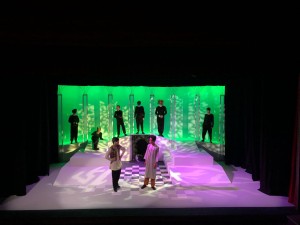
The bones of the tale are kept in Timerlake Wertenbaker’s allegorical version and thus we meet Ash’s stepsisters Ruth and Judith, with Olivia Thynne and Sofia Nicodemo bringing them maliciously and spitefully to life, whilst still staying obedient to the edicts of their equally wicked mother – Emilia Aris exuding selfishness and self-love.
The object of their malice, the Ash Girl, characterised and delivered with consummate acting skills by Rowan Brown who was barely off the stage, rose from her veiled hiding amongst the ashes to the knowledge that questions of love, hope and happiness must be answered by skills learnt through life’s experiences when often silence is the best response.
Charming and Dandini are reinvented as Prince Amir – exiled from his home and the country he loves, and Paul, yet another greedy character. Dominic Semwenga created a charming prince – serious, empathetic, earnest and almost persuaded by both his mother and Paul to just marry for fortune – any of the girls at the top of the ball’s invitation list would do. Ellie McConnell as his mother Princess Zehra created a sound maternal image whilst James Ali’s Paul hoped for fame and fortune for himself.
The troupe of ‘sins’ had worked hard not only on their considerable lines, full of long words, but on their body language too. Unmistakably indolent, Henry Barriball’s Slothworm delivered his lines lethargically, from a somnambulant position and Charlie McCarthy’s Gluttontoad was food-obsessed and eating constantly. We met Angerbird with Connor Cecil furious and resentful and Kieran O’Brien who, as Lust, tackled Ash’s father, (Sam Willmott), maybe as a reprimand for his thoughtless new marriage.
Aiding both Mother, Ruth and Judith to go to extreme lengths to achieve the wealth and fame marriage to a prince would achieve, Dan Fisher-Jaine encouraged them to think of gold, jewels, fine cloths and easy living as Greedmonkey and Oliver Horle, enticed more as Envysnake. Jack McCarthy’s Pridefly underlined that which comes before a fall, perhaps influencing the painful mutilation of the stepsisters’ feet – all to fit into that slipper – at any cost.
Connie Williams was the beautifully dressed, but rather ditsy fairy, forgetful but kind, who stepped dramatically out of a long mirror to encourage Ashy to battle her inner demons and think positively. This resulted in a coup of a transformation scene to close Act 1 with another grand dress which lit up with lights threaded through it, looking dramatic as the lights faded.
Ash did, however, have friends to look out for her. Otter, transformed into a coachman, until midnight that is, with Ethan Simmons making him caring and concerned. Then there was Owl, hooting a warning that midnight was near – Eddie McConnell as another worried friend.
Fairy magic transformed Ash’s small silver walnut shell into her coach, with friendly mice as footmen – well, one preferred to be a dragon actually, but whatever! The well-schooled mice were Lorenzo and Emily Brunellesi.
Performed against a stark background designed by Linda Hornzee-Jones, of raised white platforms at different heights with alcoves at the rear – one each for a deadly sin, the whole production was enhanced by coloured lighting designed by Brian List and eerie mood music which enriched the unrolling of the tale.
Costumes by Rosie Bottomley and Anne Franks set the story in an historic era, with those for the deadly sins, plain but well envisaged.
The care and attention to detail created an excellent production in the hands of director Ian Brown and his assistant Ben Jeffreys, which could not have been achieved, however, without the dedication and enthusiasm of an excellent cast and the support of the adults backstage. Were stars applicable here, it would certainly gain 5 out of 5.
Rules for Living – Review
Reviewed by Theo Spring
Bedlam, sheer bedlam sums up this tortuous tale of a dysfunctional family Christmas where each character has their own agenda and, as it turns out, their own rules.
The undoubted skills of each member of the cast to create roles of such diversity, each enacted within personalities that were as strong as the cognac saved to flame the Christmas pudding.
Playwright Sam Holcroft encompassed a requirement to be able to let the audience in on idiosyncrasies of the cast. Through the technical wizardry of Stephen Thurlow a large screen revealed, from amongst other foibles, that Matt lied when he was sitting down and eating and that Mum Edith cleaned everything, including her husband’s bald head, in order to keep calm and not lose her rag.
The family set-up is of Edith’s two sons Matthew and Adam returning to the family home for Christmas Day lunch. Adam with his wife Sheena and gluten-free requiring daughter Emma, and Matthew with his girlfriend Carrie who, it turned out, had had to invite herself, which must have spoken volumes but not to her. The boy’s dad, Francis, is to return home from hospital to spend the day in his own home.
Lauren Milson and Michael Rahman as Carrie and Matt were perceived at the start as idyllic lovebirds. Required to effervesce almost throughout the play, Lauren ‘s Carrie was bright, sparkly and funny as well as able to use the character’s musical stage ability to reveal, through dance, her growing realisation that Matt is in love with his sister-in-law Sheena. Michael is constantly avowing platitudes, always delivered sitting down and eating and so his fabrications are divulged to the audience. Both comedy and tragedy are revealed by both characters and their delivery was remarkable.
A cornucopia of accents is required by Adam and here Lewis Wilmott excelled. His ‘rule’ is to use them to when mocking which, as he frequently did, many different voices were required. He slid easily into these and created a many-faceted and definitely screwed-up son. His neurosis was partly brought on by a demanding father and partly by his now obviously failing marriage. Sharon Laws as wife Sheena, obsessed with wrapping their daughter in cotton wool, brought huge reality to her vociferous arguing, getting louder and harsher with each glass of wine – far exceeding her plan for ‘just one with lunch maybe’. The spats with her husband spoke of disturbing reality as did the efforts of her mother-in-law Edith to smooth everything over and keep the party calm. Ignoring the deep cracks appearing in her family’s relationships, Jan Robinson as Edith cajoled, commanded and oiled, never giving up and never admitting how ill her husband was after his stroke. Her efforts to make everything happy in the face of chaos added both comedy and pathos.
Arriving, once his family’s characters were well established, Geoff Thorn as Francis managed to convey his domineering and lecherous character from his wheelchair with one hand immobile – quite an achievement.
Spoken of throughout the play but appearing only briefly at the end, Maria Gallagher in her first proper adult production, made her mark well as daughter Emma.
The messy and chaotic ‘finale’ to the piece was performed with no holes barred.
Set in the wonderfully recreated kitchen and lounge area of the family home, Alan Croft’s design and the Chipstead Construction Crew brought total reality to the lunch and its ongoing preparations. Christmas was much in evidence. The tree with erratic lights speaking volumes of the fateful events to come and the cards around the walls. Lunch was real with props by Mags Alexander and Marie Ricôt who aided more to the reality of the setting.
Blessed with a cast able to turn the production more into a realistic documentary than a play and a crew who created such an accurate setting, director Grace Hopkins provided rewarding entertainment for an audience who had defeated the winter snow to attend.
The Scary Secrets Of Septimus Sloane – Review
Reviewed by Theo Spring
Flagged as a musical melodrama, this delightfully light and amusing production might also have been termed a thriller or a whodunit, have a mystic theme, be a comedy or even a pantomime, such are its many theatrical facets.Ideas are ‘lifted’, amongst others, from William Shakespeare; Wilde’s The Picture of Dorian Gray; from the rooms and weapons of the parlour game of Cluedo and the success of Blithe Spirit’s Madam Arcati to materialise the recently departed. The cast was a successful amalgamation of members of Chipstead’s Youth Theatre and the adult players and brought song, dance, mystery and a ubiquitous ‘body’ who had a starring role.
Septimus Sloane, played in a gentle avuncular fashion by Phil Wright, has seven daughters, a wife who disappeared seven years ago and has now been officially pronounced dead, and a fiancée keen to get her hands on the Sloane fortune. All seven girls created very individual characters and there were some clear and tuneful vocals using new words to existing tunes, set to precise choreography by Kirsty Hudson. As the mainstays of the play it seems invidious not to name them all so Tara Baker was the lovelorn Daisy, Rowan Brown the sensible Susan, Maria Gallagher the scheming Sabrina, Victoria Bailey the disbelieving Samantha, Ella Bowers the thoughtful Sasha and Edelia Stones and Olivia Thynne as the young Stephanie and Sharon. Their simple matching dresses with a different colour cardigan for each of them helped to identify their ‘body’ which wore the cardigan and also helped us, as the audience, to identify who had been killed (no longer wearing the cardigan) and who hadn’t (still wearing one).
Staff at Sloane Manor included one of the enigmatic twin butlers, given an appropriate obsequiousness by Nick Gane; Meryl Jones, an efficient Joyce Bricks as Septimus’ PA, an eavesdropping gardener Willie Growmore to whom Jon Laws brought excellent face-acting and the three below stairs staff. Cooking chicken soup on a wonderfully replicated Aga, Elayne Teague gave Beryl Close a grand accent. Debs Brooks as the housekeeper Olive was the Shakespearian witch who quoted “Double, double toil and trouble, Fire burn, and caldron bubble” over the stirred cauldron and whose thumbs were able to twitch at approaching evil, and Vicky van Manen did a grand metamorphosis from old to young as Old Rene.
There were five baddies to add to the plot. In fine singing voice and evil cackle, Rick Thompsett created Dr Darius Du Bad, with his sycophantic side-kick Craven Coward so amusingly played by Joe Ackermann. Then there were the three hoodlums Hughie, Llewy and Chewy – Connor Cecil, Sam Willmott and Sofia Nicodemo respectively, who doubled as the three clowns Bozo, Crusty and Coco – managing to keep their roles very different depending on whether they were being good or bad. Finally, we have the legals and the law, represented here by the other half of love-lorn Daisy, Bradley Adams as Melvin Close the lawyer and the comedy duo of Don Hindle as Inspector Little and Phil Brooks as PC Plenty, with the strong singing voice and great timing. And what was the cause of all the concern over money and murders? Septimus’ plan to marry his assistant Dr Sally Forth to whom Sharon Laws brought charm, intrigue and a certain amount of scheming. On-stage musicians were under the baton of MD Philippa Lucas and the two Directors making sense of a considerable amount of mayhem were Siobhan James and Peter van Manen.
The fun evening invited audience reactions – groans at some of the puns – and we even had our photograph taken – one for someone’s album!
Splendour Review
Reviewed By Theo Spring
This modern, striking play must surely be an actor’s nightmare. Each scene opens in exactly the same way, with glass being swept up from the carpet with a dustpan and brush, but then the dialogue changes. Sometimes with subtlety and sometimes pointed up, but full marks to the cast for unhesitatingly knowing which scene they were in and never confusing them.
Full marks to the cast also for their interpretations of four very diverse women. Set in the ‘splendour’ of a dictator’s city home, in a set designed by David Franks and oozing wealth and status thanks to Anne Franks’ set dressing and furniture, the four await the arrival of the dictator’s husband. Bearing a similarity to Samuel Beckett’s Waiting for Godot, he never comes, yet he is always expected, on his way or delayed for this and that reason, at least so says his wife Micheleine, but is she imparting the truth of her telephone calls to his office? Kirsty Cunnington was every inch the elegant well-heeled (and high heeled) wife. Loyal, used to the best and constantly trying to smooth over her husband’s non-appearance to fulfil an appointment to have his portrait taken, on camera, by a British photojournalist. This key characterisation was reminiscent of the proverbial swan – all calm above water but paddling frantically underneath as, in Micheleine’s case, her world gradually fell apart as it slowly becomes apparent that a civil war is being fought beyond the safety of the residence.
A war, however, is not exclusively outside the walls as Micheleine’s constantly acknowledged best friend is revealed through the scenes to dislike her intensely and here Jane Foster as Genevieve uses not only her words but her body language too, to indicate her feelings as she moves between friendship and animosity. It is Genevieve who, with a small grasp of the language of the country, is suspicious and soon outspoken about the interpreter’s often completely false interpretations, leading to mistrust. Katie Bignell is the kleptomaniac interpreter Gilma, using her sleight of hand and a copious shoulder bag to secrete her booty, seeming to delight in the mayhem, confusion and hurt her words are causing.
Mugged & Taking Breath Reviews.
Reviewed By Lauren Milsom & Noel Harris
A well observed and sensitively written double bill performed by our talented youth theatre. Two plays which appear very different but have common themes of friendship and bravery. Most significantly both show how easily our perceptions of truth and reality can be changed or subverted.
The stage was stunningly set with a minimalist design of a giant tree centre stage, providing the perfect backdrop for the park setting in the first play, then becoming the centrepiece of the action in the second.
MUGGED by Andrew Payne
The play opens with perfectly paced energy from Jonathan Neary (Dig) and Toby Maynard (Marky) whose witty banter quickly establish their easy friendship and shared status as the nerdy underdogs in their social sphere, whilst introducing us to their daily dilemma of choosing a route to school. The reason for their quandary soon becomes clear with the arrival of their classmates, Leon (played with arrogant aggression by Ben Jeffreys), Tayl, (a confident debut by Oliver Griffin) and girlfriends Soph (a well-deserved major role for Maria Gallagher) and Mel (Tara Baker in another strong debut role). Their entry on the scene establishes they are not friends with the other two but use brute force and aggression to dominate them in standard pack hierarchy.
One common fear unites them all: the muggers positioned in the park playground most mornings – directly in their path to school. Whether to take the long route round to avoid them or run the gauntlet is evidently a daily decision.
With time running short the girls and Marky attempt the direct route, but quickly retreat when Soph’s phone is stolen by the most menacing mugger. This turn of events shows the characters’ behaviour under stress, with Leon’s brutish bravado crumbling at the possibility of confrontation.
Marky, recognising the lead mugger (“his mum lives next door to my mum”) naively believes he can reason with him and bravely returns to the playground alone in hopes of retrieving the mobile. The horror of the subsequent knife attack on Marky is effectively played out on the faces of the watching classmates.
Thus the teens are plunged into a murder enquiry and high profile media reporting, stylishly represented by the two news anchors Sofia Nicodemo and Olunibe Morgan, and on-the-scene reporter Bradley Adams. Early in the play the author has established that each character has something to hide, and from here on the audience witness the corruption of a seemingly simple case, when the witnesses all convince each other they have more to lose by telling the truth to the police than they have to gain. Thus police assumptions and media bias present a horribly skewed picture of the tragic event as a gang related incident with Marky branded a knife-wielding delinquent equally to blame for the skirmish.
Onlookers and gawkers are used to great effect here, revelling in the media attention to lend credence to Marky’s character assassination, and perpetuate a lazily constructed stereotype of a troubled teen deserving all he got.
Dig, Marky’s only true friend, watches this scenario unfold with horror, and after much soul searching decides to tell the truth to the police. Armed with fresh evidence, the hypocrisy of the media is sharply highlighted with a dramatic about turn in their description of Marky’s character, depicting him, just as inaccurately, as a champion of justice; a flawlessly gifted high achiever popular with everyone. His teachers, family and classmates avidly latch on to this fictitious social hero the media have created and whose funeral they all attend. Once again it falls to Dig to cut through the hype, remembering the true character of the friend only he knew well and who only he, amongst the crowd, truly grieves for. Jonathan Neary’s thoughtful and sincere delivery of these final lines showed us a glimpse of the depth of feeling this talented actor can deliver and provided a touching ending the audience will long remember.
TAKING BREATH by Sarah Daniels
The stunning centrepiece tree, designed and constructed by Nick Gane, comes into its own in this second play of the night, as the focus for an ecological demonstration played out among its branches.
The play opens on three set pieces
- The turbulent relationship between two sister dealing with their grandmother’s death
- A band of Eco-warriors trying to save a tree “the lungs of the planet” from destruction
- A young man lying comatose in a hospital bed, his worried family at his side
Three separate scenarios all intrinsically linked.
In Taking Breath five young people spend a night on a tree platform to prevent the destruction of the trees and some houses. One of the protesters, Elliott, tries to leave the tree, falls and is left unconscious. As he is lying there, he encounters Lucy, a servant who in 1913 worked in one of the houses that is to be demolished. The dramatic thread weaves backwards and forwards in time. In the opening scene, we learn that Elliott has been in a coma for a week. We then have scenes on the tree platform interspersed with Lucy telling Elliott about the suffragettes, how she was sexually harassed, how she had tried to frighten off the son of the house by telling him she had a boyfriend. Finally we have scenes in the hospital where Alana and Steve meet and we see them on the tree platform. Through her great-grandmother’s courage in adversity Alana finds peace with herself and strength to move on.
“Sometimes in life, the most courageous thing is to keep breathing.”
From the outset, Emily Foster pulled no punches as the aggressive, troubled Alana, older sister to the quiet, bookish Gemma (Gemma Bottomley). Alfie Earl Day gave a mature performance as Eco warrior / time-traveller Elliot taking the incredible developments in his life in his stride.
Monty Camisa Bundy, Ella Bowers, Kate Batcheler and Henry Barriball, fellow eco-warriors provided more light relief with well delivered comic earnestness.
Katie Bignell brought great energy to Lucy the suffragette, whilst Luke Steel and Victoria Bailey showed good emotional depth as Elliot’s concerned family.
Both plays were directed with great insight and sensitivity by directors Nick and Jane Foster, who produced well-paced, believable and mature performances from an excellent ensemble cast. Congratulations to all cast & crew on bringing these high quality productions to the Courtyard Theatre.
The Keeley Plate 2017
The Keeley Plate is an award for the most promising performance by a member of the Youth Theatre in the season, and what a season we’ve had.
The Keeley Plate committee considers plays from the last AGM until now. That’s from Dial M for Murder ’til now. The qualifying plays, where youth theatre members were represented, were Hospital Food, A Handbag, Twelfth Night, Satchwell Road Can Take It, Collaborators and A Doll’s House. Only 50% of those were Youth Theatre plays. It was wonderful to see Youth Theatre members having a full share in three so-called adult plays, very much to be encouraged. The Keeley Plate Committee, made up of Grace Hopkins, Vicky Van Mannen and me (Michael Rahman) along with valued feedback from directors and others considered 39 youth theatre members, across 55 different roles. What did we find? Camaraderie in shaved heads, bravery with iambic pentameter, a movie and a sequel.
We’ll start with some new faces. The first time on stage, back stage – their first stage with The Courtyard Theatre – can be daunting to the young, so we were so impressed to see Rowan Brown and Kieron O’Brien in Satchwell Road Can Take It. So confident, good diction, they let their faces be seen. We look forward to seeing more of you.
Moving on to those faithful ones who have returned to this stage. We’ve come to know them over the last few years and have seen wonderful progression this year particularly from Edie Nelson, Jonathan Neary, Simon Perry, Zoe Kirk, Monty Camisa-Bundy, Emily Foster and Vicky Bailey. We’re so excited to think of what their continued progression will mean for us, the audience, in the coming season.
Then we think of those we’ve seen from their childhood to their near adulthood. We think of Katie Bignell, Ethan Elsdon and Ben Jeffries, none of whom have confined themselves solely to youth theatre plays over the years (Skellig, Arsenic and Old Lace, The Crucible). We really have valued your performances over the years and truly appreciate the hard work and dedication you have brought to the stage. You’re probably on the verge of leaving the youth theatre. Please don’t forget us. How we truly value men and women in their ’20’s. Hard to cast right? Sometimes we lose our youth theatre members but there’s so many opportunities for exciting plays in the future if we know the likes of you will be available to be cast.
We must remember the two films which formed a part of Satchwell Road Can Take it. Not least of all for the acting styles needed for this different medium, but also the involvement of our youth in the making of it too. How forward looking that was. The Chipstead Players are brave; it forms part of our reputation, and how encouraging it was to see our youth theatre embrace innovation and new ideas. Laugh out loud funny it was too!
When thinking of awarding the Keeley Plate four people stood out to us.
Jonathan Neary – He appeared in the Satchwell Road film, tackled the iambics in Twelfth Night, but most memorable for his impressive character switch in A Handbag earning spontaneous applause mid-scene.
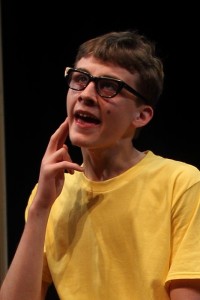
Vicky Bailey – She really did impress in Twelfth Night. To convey multiple identities and character while spouting a whole glut of poetry is skilful indeed.
Ethan Elsdon – He portrayed true maturity in Hospital Food, acting in a challenging role. Along with others he bravely shaved his head, raising money for the Teenage Cancer Trust in the process. He took the role to the Leatherhead Festival. He then had a good stab at Shakespeare and the film in Satchwell. A memorable year.
Monty Camisa-Bundy – He appeared in A Handbag but we agreed that his comic performance in Twelfth Night was a revelation. Put him next to our seasoned Mike Strong in scene after scene and you forget there’s an age difference, truly hilarious. Do more comedies please!
We wanted to mention you four in particular and are delighted to award the Keeley Plate this year to – Jonathan Neary.
(We were thrilled that Hope Elsdon, the holder of the plate over the last year, was on stage to present the award to Jonathan in person. It was also so good to see a number of Youth Theatre members present at the AGM)
A Streetcar Named Desire Review.
Reviewed By Theo Spring – The Croydon Advertiser.
Without exaggeration, I was completely bowled over by this production which was extraordinarily good.
David Franks’ set design brought an instant touch of the architecture of New Orleans with its beautifully achieved fancy scroll work which topped the Kowalski apartment and joined it cleverly to Hubbell’s, depicted as living above them. The whole layout had been carefully thought through, with its invisible but solid walls, an intimate outdoor area and its internal rooms. A major achievement.
The acting skills for the role of Blanche DuBois are so heavily demanding in interpreting an emotional, flighty, disorientated and lost character that amateur groups rarely present the production. Here, however, Siobhan Ames created a Blanche imbued with a history of lies, subterfuge, wheedling and affection, who carried the weight of the script and delivered the role in a faultless southern drawl – her performance was spellbinding.
Not only did the Players find such a leading lady, but cemented the production with a first rate cast who delivered their characters with equal ability Angharad Mair Davies as Stella strongly brought out her divided loyalties of love for her sister Blanche and her husband Stanley, adding frailty and despair to the play’s emotional turmoil.
Anger and distrust were brought to the mix by Noel Harris whose Stanley was demanding and explosive, seeing through Blanche’s deceptions and wanting her to leave, going where he cared not. It is on the ability of these three characters that the success of the play rests but those in the smaller roles were equally able and contributed to its strength. Lewis Wilmott conveyed the hope and almost child-like character of ‘Mitch’ who fluctuates between the spruced-up beau bringing Blanche flowers to the urgent and angry man on hearing the truth about Blanche’s past. A chameleon delivery.
The almost unbearable heat is ever present during the play, endorsed by the men’s sweat-dampened vests. Blanche’s constant companion is a white perfumed hanky – artfully used to convey the heat and much more. This same heat frays tempers too, with neighbours Krissi Perry and Geoff Thorn as Eunice and Steve Hubbell loudly squabbling but happily making up too. Richard Haslam as Pablo makes the fourth in the crucial men’s poker game where alcohol and the heat create volatility. Joseph Ackerman faces Blanche’s seductive wiles when trying to collect a newspaper subscription and Lauren Milsom has two cameos as Rose and the nurse. Michael Rahman is the doctor who, as Blanche is finally institutionalised, realises that she will struggle against a straight jacket but could be wooed to submit quietly by a small bunch of flowers and a courteous invitation.
Costumes by Anne Franks and Rosalind Hayes added much to the vision of the 1940s era and under the expert direction of Julie Cumbo, the cast moved fluidly around the set, bringing a natural air to this famous play with its torrid overtones.
This very talented cast, directed with such in-depth understanding of the play by Julie Cumbo brought a truly West End worthy drama to The Courtyard.

